

Visitor’s Guide To The Fabulous Carnegie Museum of Art In Pittsburgh
Here’s my guide to visiting the fabulous Carnegie Museum of Art in Pittsburgh Pennsylvania.
You may not think the “Steel City” of Pittsburgh is an art mecca.
But for a small city, the beloved Carnegie Museum of ART (“CMOA”) packs a surprisingly art punch, with international flair.
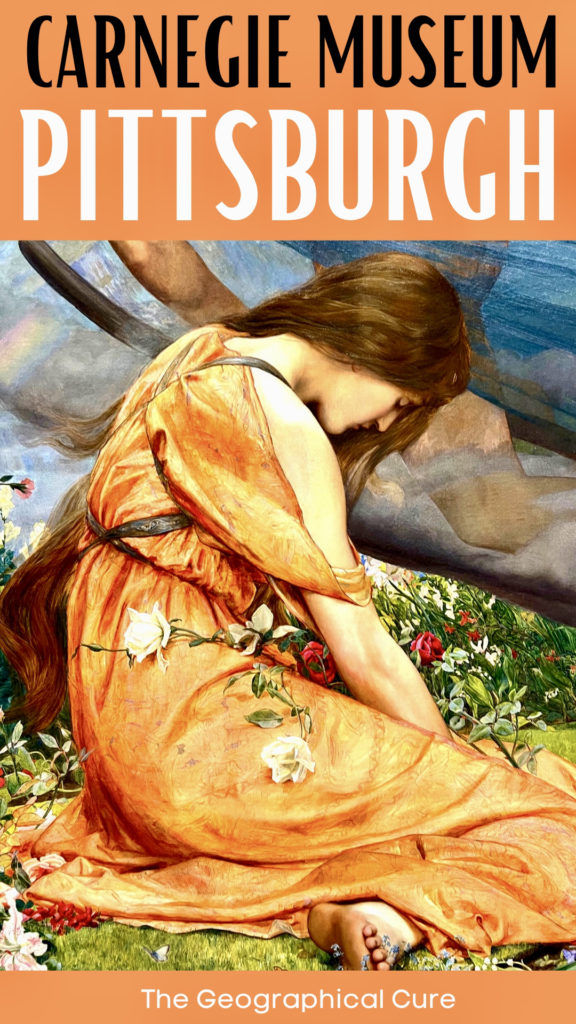
Founded by industrialist and philanthropist Andrew Carnegie , this gorgeous museum is in Pittsburgh’s lively Oakland neighborhood near the University of Pittsburgh and Carnegie Mellon University.
In this Carnegie Museum guide, I give you an overview of the museum’s history and identify its must see masterpieces. There’s something to appeal to every art enthusiast, especially lovers of Impressionism.
READ : Best Things To Do in Pittsburgh
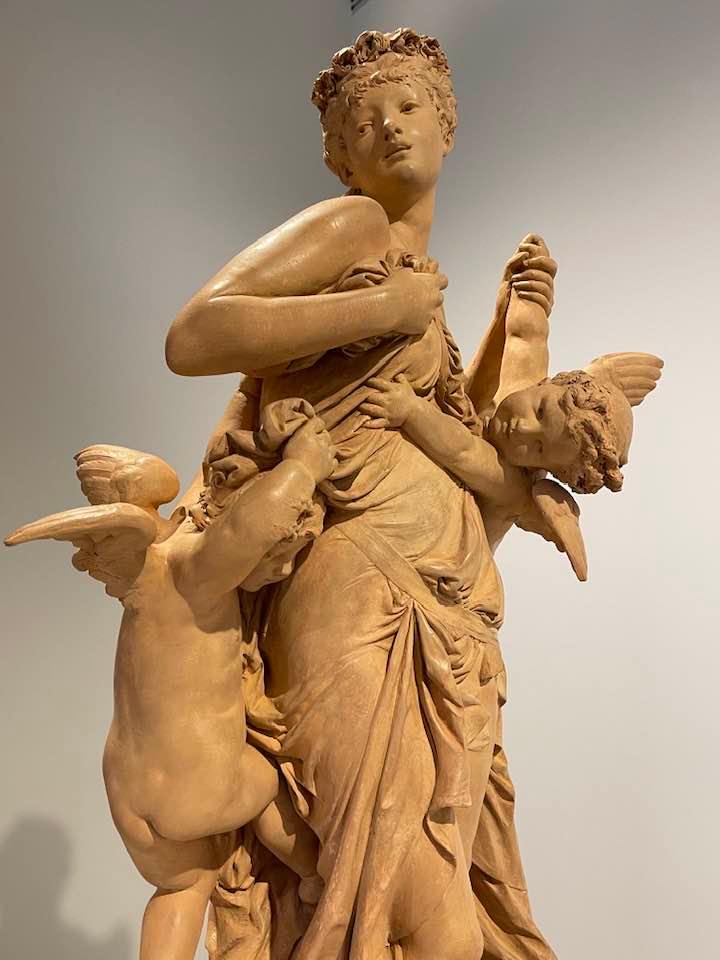
Overview of the Carnegie Museum of Art
There’s a lot of fascinating things to see at the Carnegie. I’ll give you a quick overview so you know what to expect on a visit.
The museum is much larger than you might suspect, with a rich array of visual treats. There are many wings and dozens of galleries. The wide-ranging galleries are devoted to art from ancient times to cutting edge contemporary works.
Since its inception in 1895, Carnegie wanted the museum to reflect “tomorrow’s old masters,” not just ancient works. As a result, CMOA is considered the first museum of modern art in the United States.
Some of Carnegie’s first acquisitions were contemporary works by emerging American artists Winslow Homer, James McNeill Whistler, and Edward Hopper.
On the first floor of the Carnegie Museum of Art, you’ll find the Carnegie’s Hall of Sculptures, the Hall of Architecture, and the Forum Gallery.
The Heinz Gallery is one the second floor. This gallery houses temporary exhibitions, with room after room of high ceilings.
Launched in 1974, the Scaife Galleries occupy most of the second floor. This collection is CMOA’s crown jewel.
Sarah Mellon Scaife was a sister of Pittsburgh tycoon Richard Mellon. She gifted the massive Beaux Art galleries and a slew of important works to CMOA. Her bequest alone nearly doubled the museum’s space.
The Scaife galleries feature European and American art from the Renaissance to the present. There’s a strong collection of Impressionism. The collection is presented in reverse chronological order.
On this floor, you’ll also find the Alisa Mellon Bruce Gallery of Decorative Arts & Design.
The Carnegie Museums also houses several other specialized museums and halls dedicated to natural history, ancient Egypt, and Native Americans. But in this article, I focus solely the museum’s fine art collections.
Guide To The Carnegie Museum: What To See
Let’s take a tour of the best art works and masterpieces at the Carnegie Museum of Art.
1. Hall of Sculpture
The design of the Hall of Sculpture is modeled after the columned inner sanctuary of the Parthenon in Athens. It’s constructed of brilliant white marble, from the same quarries used to build the 5th century B.C. Parthenon.
The original purpose of the room was to house the museum’s collection of reproductions of Greek, Roman, and Eastern sculptures. Most of those have been moved into the Hall of Architecture.
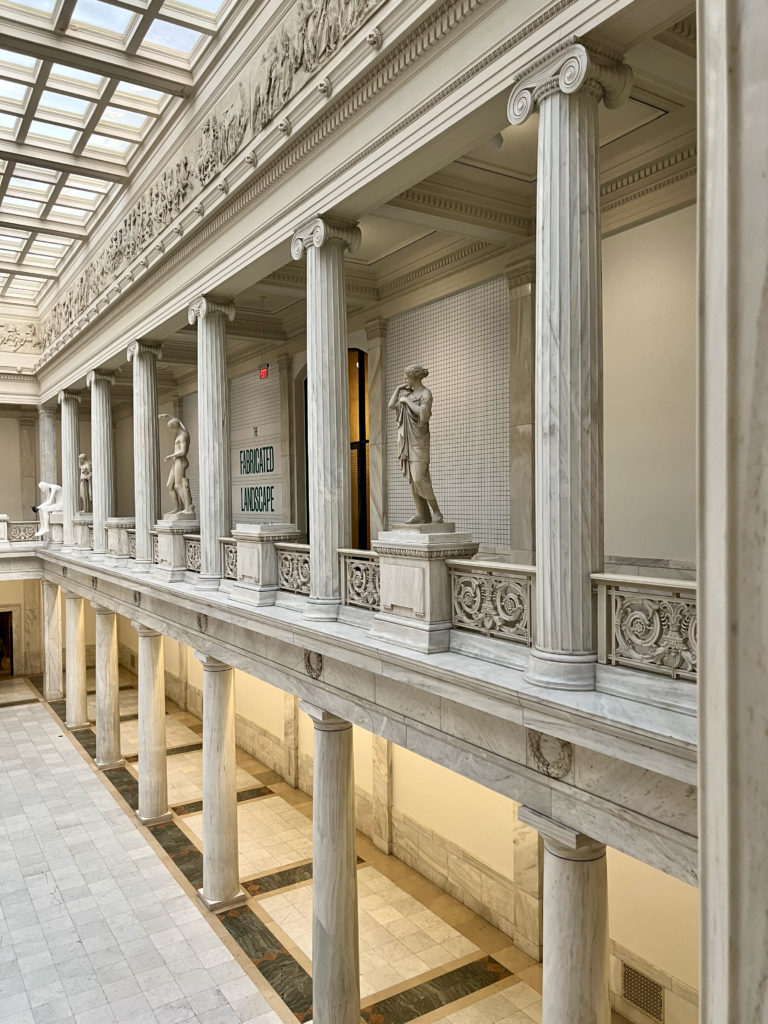
But there are still statues decorating the second floor balcony. The statues are replicas of statues from the Louvre , the Vatican Museums , and the British Museum.
Directly below the skylight is a carved frieze, replicating the decorative band that once decorated the Parthenon.
Today, the Hall of Sculpture is used for site specific performances, installations, and exhibitions.
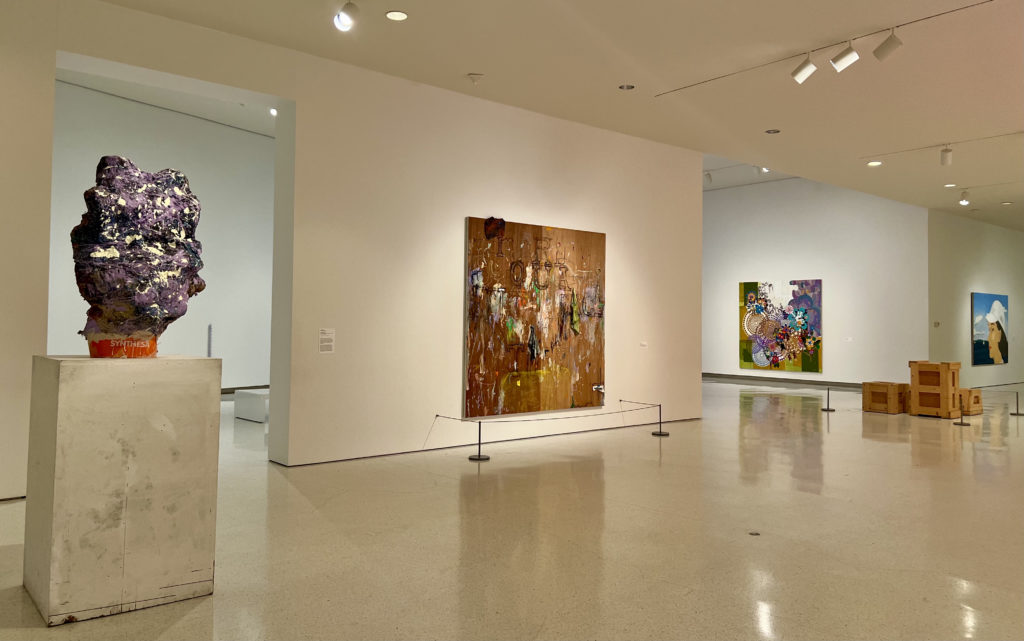
2. Scaife Contemporary Collection
You’ll start your Scaife visit in the contemporary art section, accessed from the second floor atrium. This collection covers works from 1945 to the present.
CMOA has assembled and displayed 130 of its diverse holdings of modern and contemporary art pieces.
The works on display reinvent traditional mediums and reflect pressing social and political issues. They include works from the genres of Pop Art, Conceptual Art, Abstract Art, Minimalism, and cinema.
You’ll find recognizable works by Andy Warhol and Keith Haring. There are also more cutting edge works Anton Rooskens, Ellsworth Kelly, Sol Le Witt, and Rafael Ferrer.
There are also conceptual and performative videos and collage films.
One of my favorite piece in this section of the museum was an eerie installation by French artist Louise Bourgeois , Cell II, from 1991. It’s part of a series focusing on the dark recesses of the psyche.
The early to mid 20th century art works are some of my favorites in the museum collection. That period saw the birth of modernism.
A new era of visual artists challenged existing art styles. Beauty and aesthetics gave way to abstraction, expression and symbolism.
There are classics by world renowned artists on display — Willem de Kooning’s Woman VI , Alberto Giacommeti’s Walking Man I , Jackson Pollock’s No. 4 , Mark Rothko’s Yellow and Blue, and Piet Mondrian’s Trees.
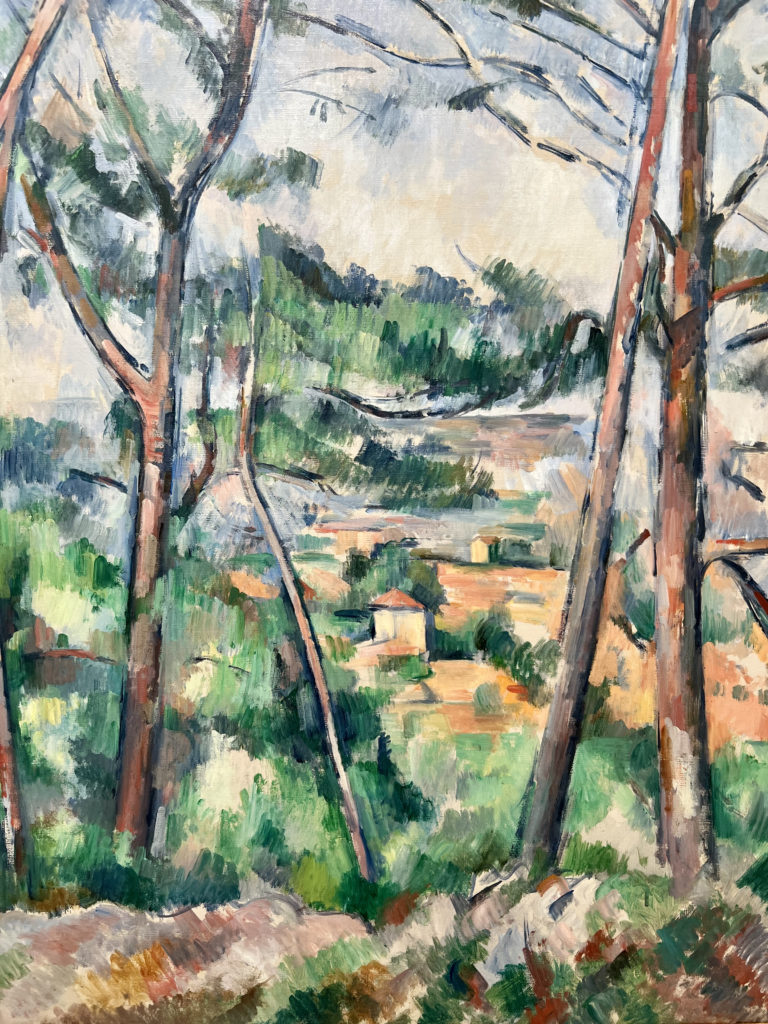
3. Scaife Galleries, 19th Century Art
The 19th century galleries are the most popular area of the museum. The galleries house works from 1850 to the present in 12 rooms. This includes the ever-popular Impressionist, Post-Impressionist, and late 19th century art.
Scaife began collecting Impressionism in 1962, with the help of a CMOA director. Her taste was mostly classic. But she made some adventurous choices too.
Over the years, she and her family purchased and donated 28 major paintings and pastels by Paris artists. The Impressionist works on display include pieces by top shelf names like Monet, Manet, Pissarro, Renoir, Degas, and Matisse.
Pride of place belongs to Claude Monet’s Water Lilies . It’s one of six large panels that Monet painted between 1915 and 1926. It’s nearly 20 feet long and 6 feet wide.
It’s not quite as luminous as Monet’s water lilies on display in Paris’ Musee Marmottan Monet or the Musee de l’Orangerie . But still a relative rarity to see one in the United States.
READ: Guide To Monet’s Art in Paris
There are also three pieces by the ever popular Vincent Van Gogh . There’s a beautiful drawing, a painting of wheat fields created just days before his death , and a painting of Le Moulin de la Galette in Paris.
You’ll also find several Renoirs, some first rate Degas paintings and sculptures, and some beautiful John Singer Sargent paintings.
There are also quite a few sculptures by the indomitable French artist Auguste Rodin , the greatest sculptor of the 20th century.
My favorite pieces in the collection were Wheat Fields After the Rain by Vincent Van Gogh, Girl Under Apple Tree by Edvard Munch, a bust of Dorothy Heseltine by Aime-James Dalou, Venetian Interior by John Singer Sargent, The Bath by Degas, and Hand of God by Auguste Rodin.
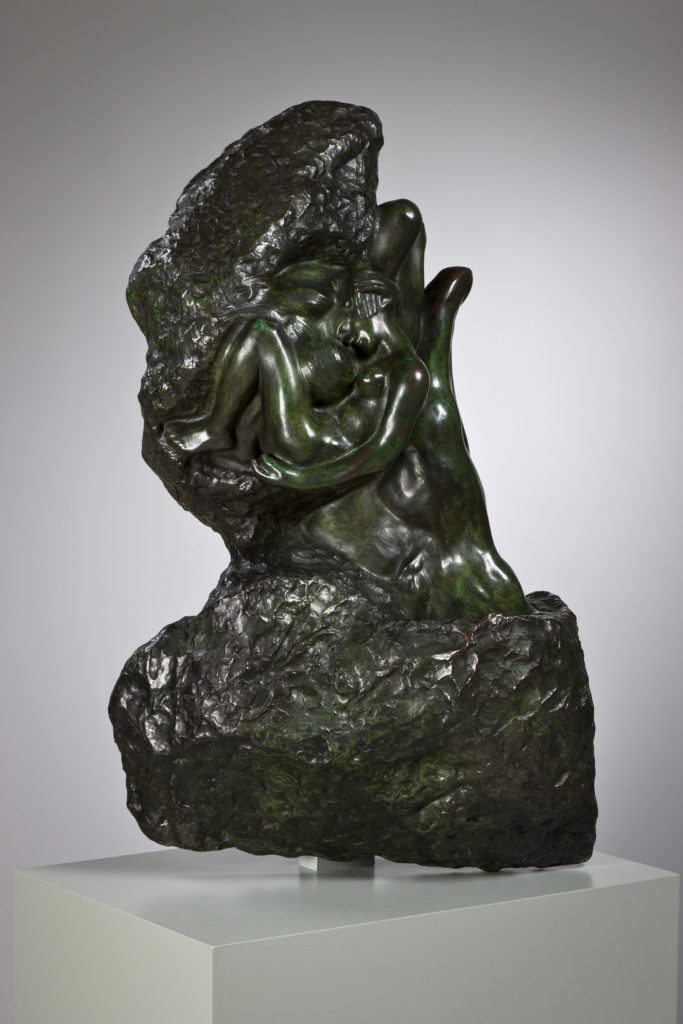
The first two I mentioned are shown above.
After these galleries, you’ll encounter the 19th century Realism and Rococo paintings. These include works by Bougeureau, Gustav Courbet, Fantin-Latour, James Whistler, Thomas Eakins, and John Singer Sargent.
There are couple galleries dedicated to sculpture.
You’ll find works by all the greats — Auguste Rodin, Daniel Chester French, Carpeaux, Maillol, Charpentier, and Canova. There’s even a bust by the great Italian Baroque artist Gian Lorenzo Bernini .
4. Decorative Arts & Design | Ailsa Mellon Bruce Galleries
This area of CMOA houses over 34,000 decorative objects. They’re arranged chronologically and feature a broad spectrum of visual art.
You’ll find glass works, porcelain, ceramics, wood carvings, china, etc. The collection celebrates the extraordinary in every day objects.
My favorite pieces were Gerrit Thomas Rietved’s Zig-Zag Chair, Louis Comfort Tiffany’s stained glass windows and lamps, and some stunning Arts and Crafts era pottery and furniture. You’ll recognize the designs of Gustav Stickley, the Roycrofters, and Charles Rene Mackintosh.
A seminal piece is the Tennyson Vase, a four foot high hammered silver vase. It was created as an ode to Alfred Lord Tennyson’s poems about Arthurian legends. It was a symbol of British strength in the 9th century.
The Bruce Galleries also highlight contemporary design and crafts in glass, wood, ceramic, and metal. A beautiful vignette is a display of 20th century glass art set in front of large windows facing Forbes Avenue.
5. Heinz Architectural Center
Established in 1990, the Heinz Architectural Center is a permanent gallery that houses changing exhibits of world architecture.
It’s dedicated to the collection, study, and exhibition of architectural drawings and models. But boasts nearly 6,000 objects, including photographs, artifacts, casts, drawings, etc.
An onsite library houses 7,000 books And there is 4,000 square feet of exhibition space.
6. Hall of Architecture
The Hall of Architecture is part of the Heinz Architectural Center. I think this hall is a real highlight of the museum. It’s filled with plaster casts of outstanding classical, ancient, and medieval works.
It’s incredibly unique. I’ve never seen anything quite like it in thousands of museum outings.
As part of his effort to “bring the world to Pittsburgh,” Carnegie commissioned plaster copies of some of the world’s most iconic buildings and sculptures.
They were created by master craftsmen. If the citizens of Pittsburgh couldn’t get to Europe, they could at least see what they were missing.
Architectural cast collections were incredibly popular in the late Victoria era. Their popularity subsequent waned.
Hence, there are now very few collections in the world. CMOA’s only rivals are the Victoria and Albert Museum in London and the Musee National des Monuments Francais in Paris .
You can see copies of Venus de Milo and Winged Victory of Samothrace from the Louvre . You can admire Lorenzo Ghiberti’s bronze doors, which were created for the Florence Baptistery . Michelangelo dubbed them the “Gates of Paradise.”
You can also see Nicola Pisano’s pulpit from Siena Cathedral . It’s considered one of the first works of Renaissance art.
As for the Parthenon, there’s lots of goodies. There’s a miniature model of the Parthenon.
And life-size sculptures from the Parthenon’s frieze. The actual sculptures are the subject of an ownership dispute . They’re housed in both the British Museum in London and in the Acropolis Museum in Athens.
The largest recreation is the entire west facade of the Gothic Abbey Church of Saint-Giles in France. It’s a one of kind marble, and may be the largest architectural cast ever made.
In the winter, the hall is filled with themed Christmas trees.
READ : Guide To The Top Holiday Attractions in Pittsburgh
7. Crowning of Labor Mural and Grand Staircase
The museum’s three story Grand Staircase is the centerpiece of CMOA’s 1907 addition. The marble staircase is lovely.
But what really catches your eye is the mural covering almost 5,000 square feet of wall space. It’s called The Crowning of Labor. The theme is the turn of the century ideas of uplift and progress achieved through hard work.
The mural cycle consists of long vertical panels along the perimeter of the staircase. They show workers toiling away. One the second floor, there’s an allegorical knight (a stand in for Carnegie) who’s crowned by a winged female.
The mural cycle was created by Pittsburgh native John White Alexander between 1906-08. Alexander had full artistic license.
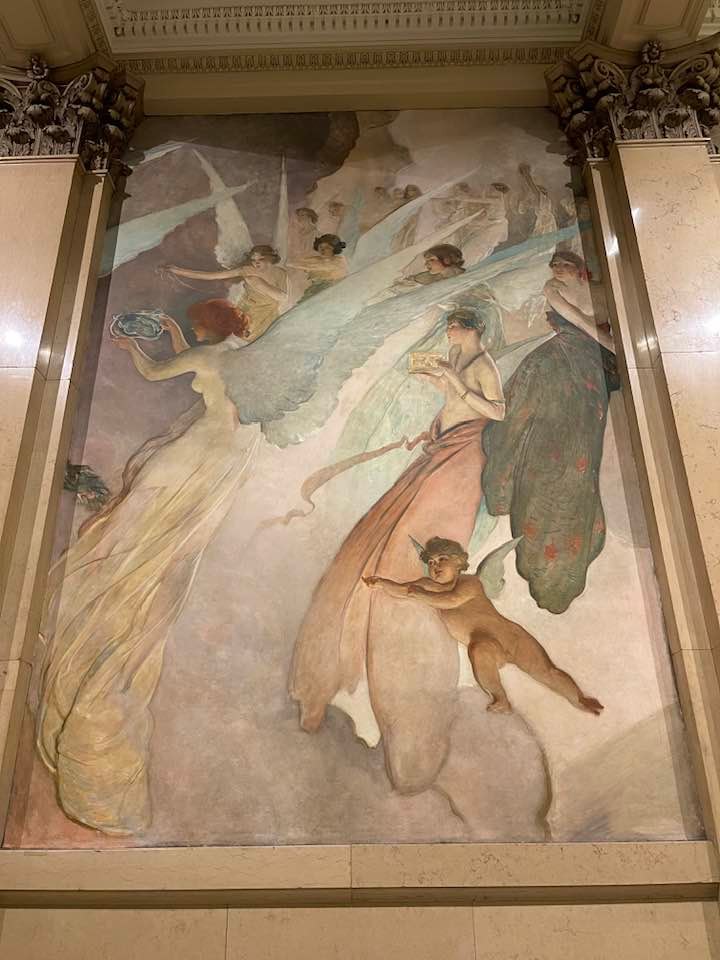
The mural has a dark to light plan that’s bathed in light from the center skylight. The mural was renovated in 1995 and its colors sparkle.
The mural cycle was created by Pittsburgh native John White Alexander between 1906-08. Alexander had full artistic license. He produced a depiction of the turn of the century ideas of uplift and progress achieved through hard work.
The murals were actually created in New York City and shipped to Pittsburgh.
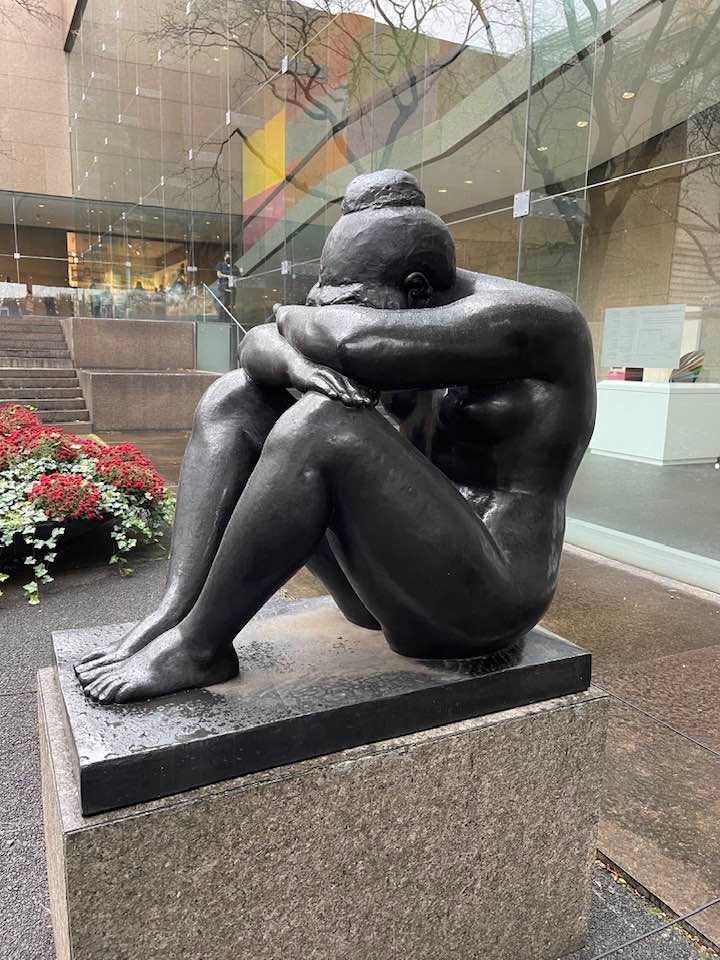
8. Outdoor Sculpture Court
The sculpture court was also a Scaife donation. In 1974, when CMOA expanded to create more gallery space, it also created an outdoor sculpture court.
You can simultaneously enjoy art, architecture, and landscape. It’s the perfect place for a cup of coffee or picnic lunch.
The courtyard is a triangulated angular space with multiple terraced levels and faced with glass and granite walls. Within the court are 16 sculptures varying from intuitive design to gridded modernism.
David Smith’s Cubist-inspired Cubi XXIV was one of the the first modern sculptures to be installed in the courtyard. It also serves as a frame for Andy Warhol’s large silk screen prints of Andrew Carnegie in CMOA’s cafe area.
I particularly liked Aristide Maillol’s poignant Night.
You can also see 11 neon sculptures from Tavares Strachan’s Encyclopedia of Invisibility . The sculptures ribbon the building’s exterior.
Practical Guide & Tips for Visiting the Carnegie Museum of Art
Address : 4400 Forbes Avenue Pittsburgh PA
Hours : Closed Tuesdays. Open Mon & Wed-Sun from 9:00 am to 5:00 pm. On Thursday night, the museum is open late until 8:00 pm. The best time to go? Thursday after 3:00 pm with a discount.
Entry fee : Adults $19.95, children 3-18 $11.95, under 2 free. If you buy online, use AFTER3 to get a 50% discount if you visit on weekdays after 3:00 pm.
Admission also gives you access to CMOA’s sister museum, the Carnegie Museum of Natural History. But doing both museums in one day could definitely result in museum fatigue. There’s a lot to see and digest.
How Long should you spend at the Carnegie? I’d budget 2-3 hours minimum.
Online tickets : Click here to buy tickets and reserve a time slot online
Carnegie Cafe : This lovely upscale cafe offers casual dining, with an espresso and wine bar. You can get small plates, salads, and sandwiches. You can dine in, get food to go, or head to the outdoor sculpture gallery.
Parking : There’s a dedicated parking lot for the museum on Craig Steet. The current cost is $7.
Virtual Tour : You can take a virtual tour of CMOA by visiting their collections here .

I hope you’ve enjoyed my guide to Pittsburgh’s Carnegie Museum. Interested in other United States destinations? You may enjoy these guides:
- 7-10 Day Itinerary for Vermont
- 10 Day Itinerary for New Hampshire
- 25 Most Beautiful Towns in New England
- 10 Day Itinerary for Coastal Maine
- Fall Foliage Road Trip in New England
- 2 Day Itinerary for Philadelphia
- 3 Day Itinerary for Boston
- What To Do In the Berkshires
- Best Art Towns on the East Coast
- Less Touristy Destinations on the East Coast
If you’d like to visit Pittsburgh’s Carnegie Museum of Art, pin it for later.
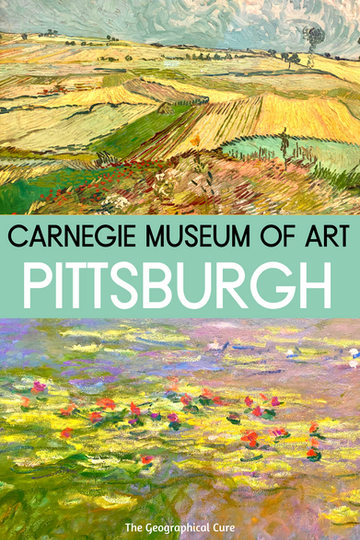
Leave a Comment Cancel reply
Save my name, email, and website in this browser for the next time I comment.
Last Updated on February 13, 2023 by Leslie Livingston
Virtual Tour
Virtual Tour: Fauna installation at Carnegie Museum of Natural History
Fauna is an all-ages interactive mechanical sculpture that engages the public about extinction and wildlife adaptation in the Anthropocene through an elaborate, kinesthetic hand-operated “penny smasher.” Participants pick designs for both sides of their penny: one side features extinct + critically endangered animals (with several designs from Justseeds artists!) and the other side features tracks + silhouettes of urban adapter animals. Years in the works, this project made it’s debut this January at the Carnegie Natural History Museum in Pittsburgh, part of We Are Nature: A New Natural History , a series of interventions in the museum space curated by Nicole Heller.
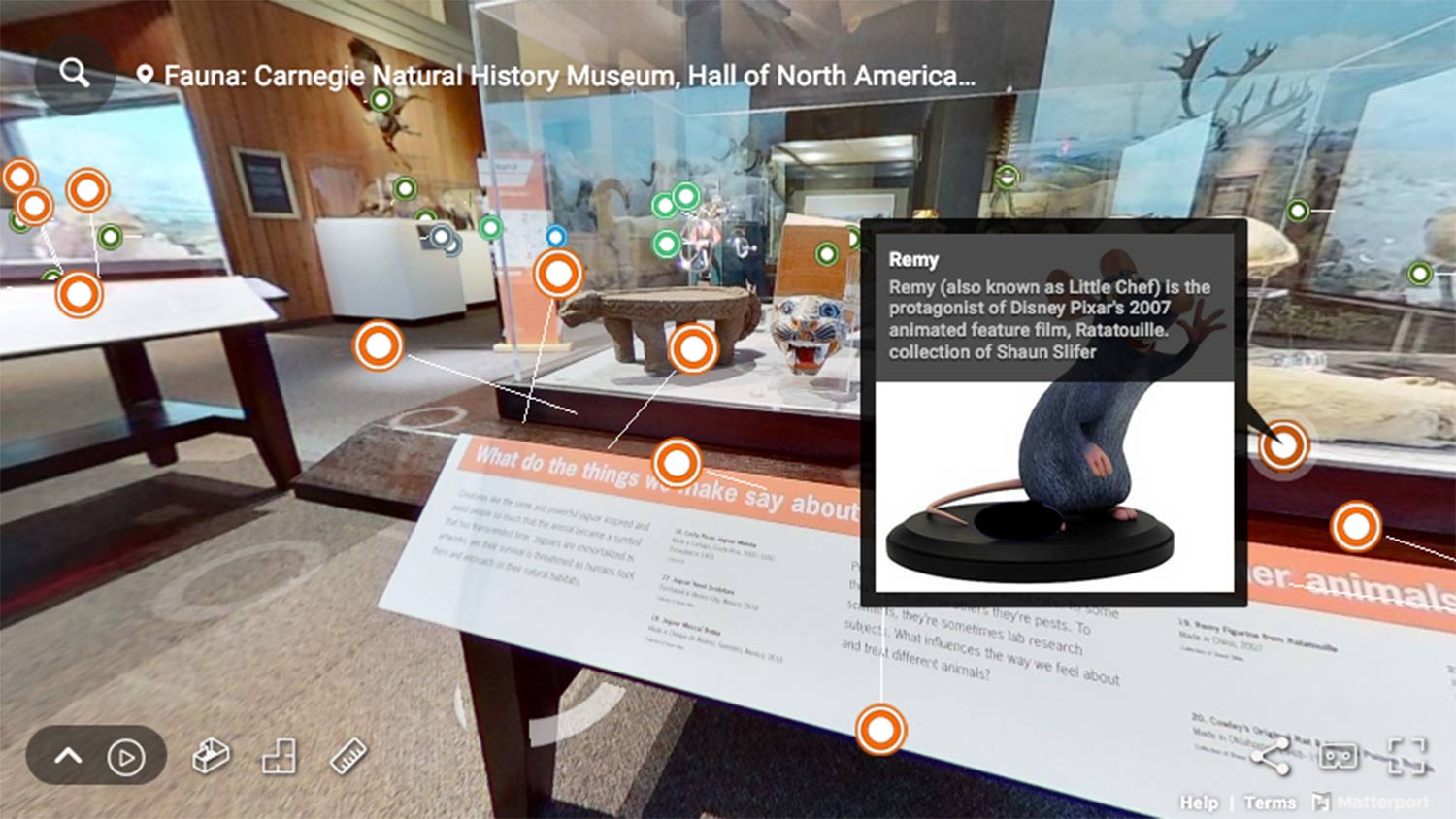
You can find Fauna in the Hall of North American Wildlife , positioned along with two new exhibition cases with objects curated by myself in collaboration with Nicole and the museum’s various collections managers. We’ve pulled together a selection of cultural objects and biological specimens which build on the stories of the animals represented on the pennies: the shell and skull of a critically endangered Kemp’s Ridley Seat Turtle, for example, alongside the disposable plastic bags that often litter their environment with lethal consequences.
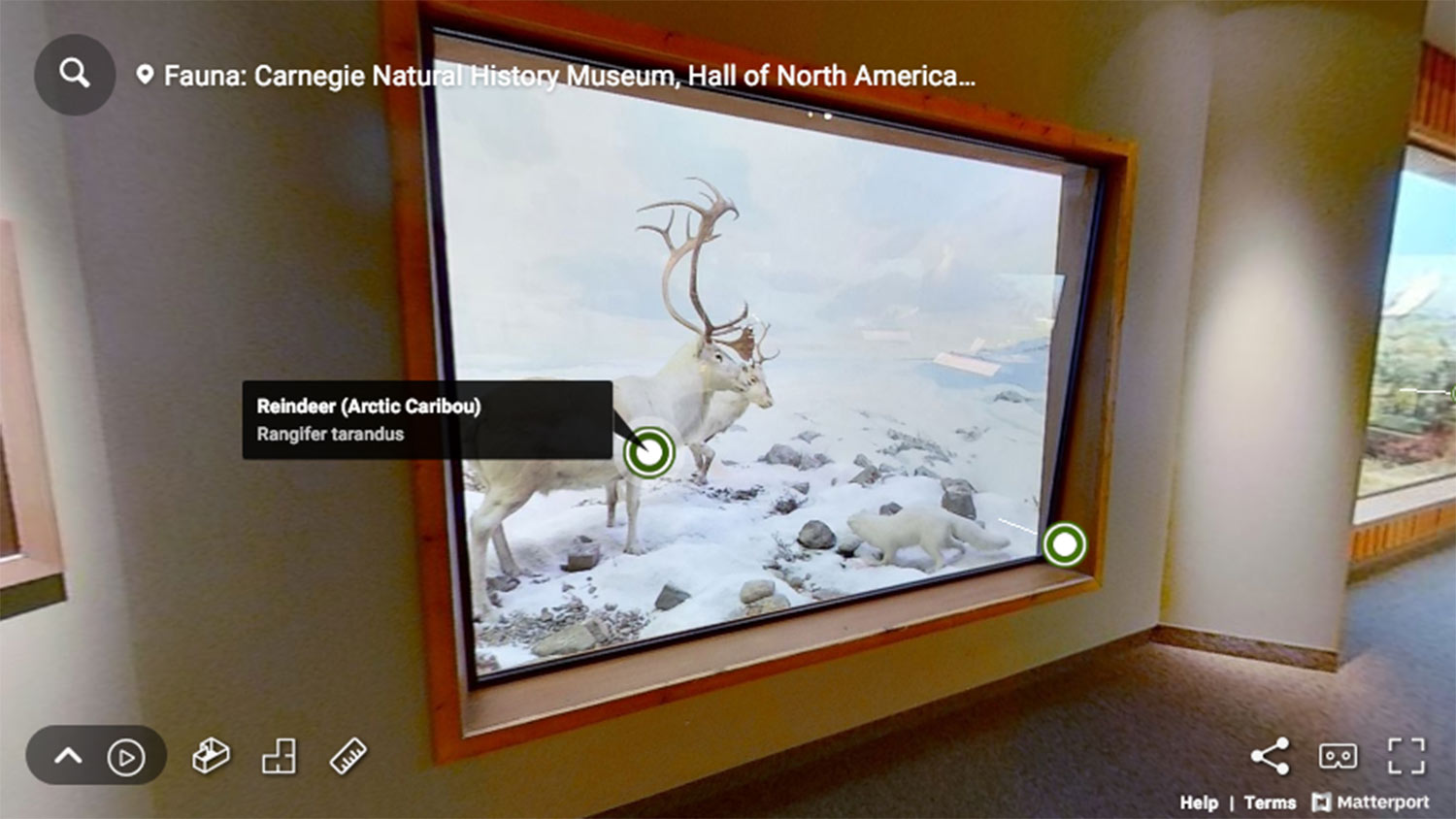
Artist Amy Garbark helped with some solid photo documentation of the installation, including creating a unique virtual tour of the space using a Matterport 3D camera. This gives us the opportunity to show you the entire environment that Fauna is currently thriving in. I’ve gone through the whole room and labeled all of the animals on display in the permanent exhibits, and I’ve also labeled all of the objects in the new cases that I co-curated. It’s a lot to take in, so spend some time with it when you can!
Unfortunately you can’t smash a penny on the virtual tour, but you can still buy pennies with designs by Justseeds artists from the first edition from Justseeds here !
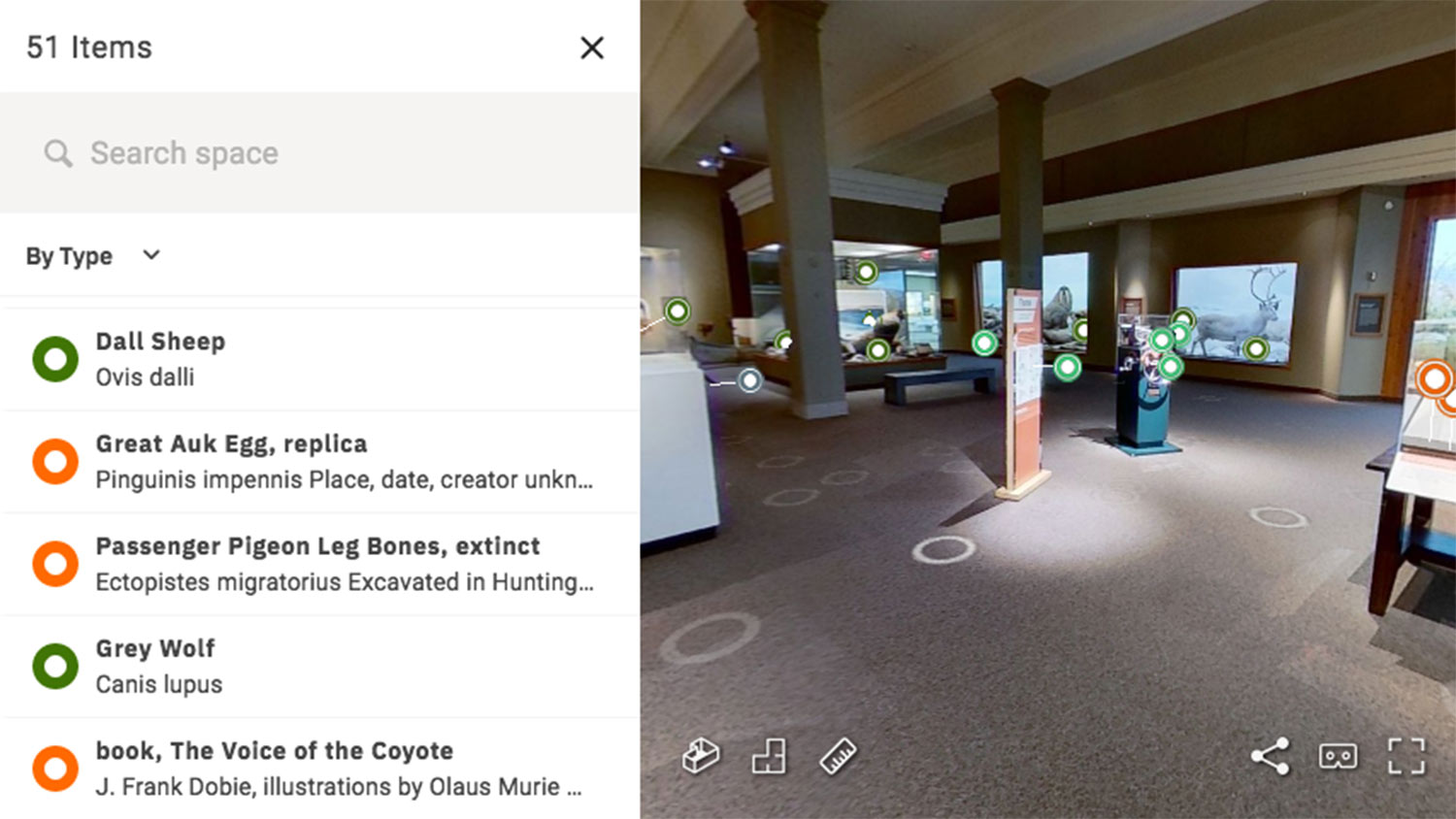
If you’re in Pittsburgh or planning to visit, find out everything you need to know about seeing the Fauna exhibit right here . There’s a change machine and a bowl of pennies in case you forget yours, but the penny bowl is often empty so grab some before you come by.
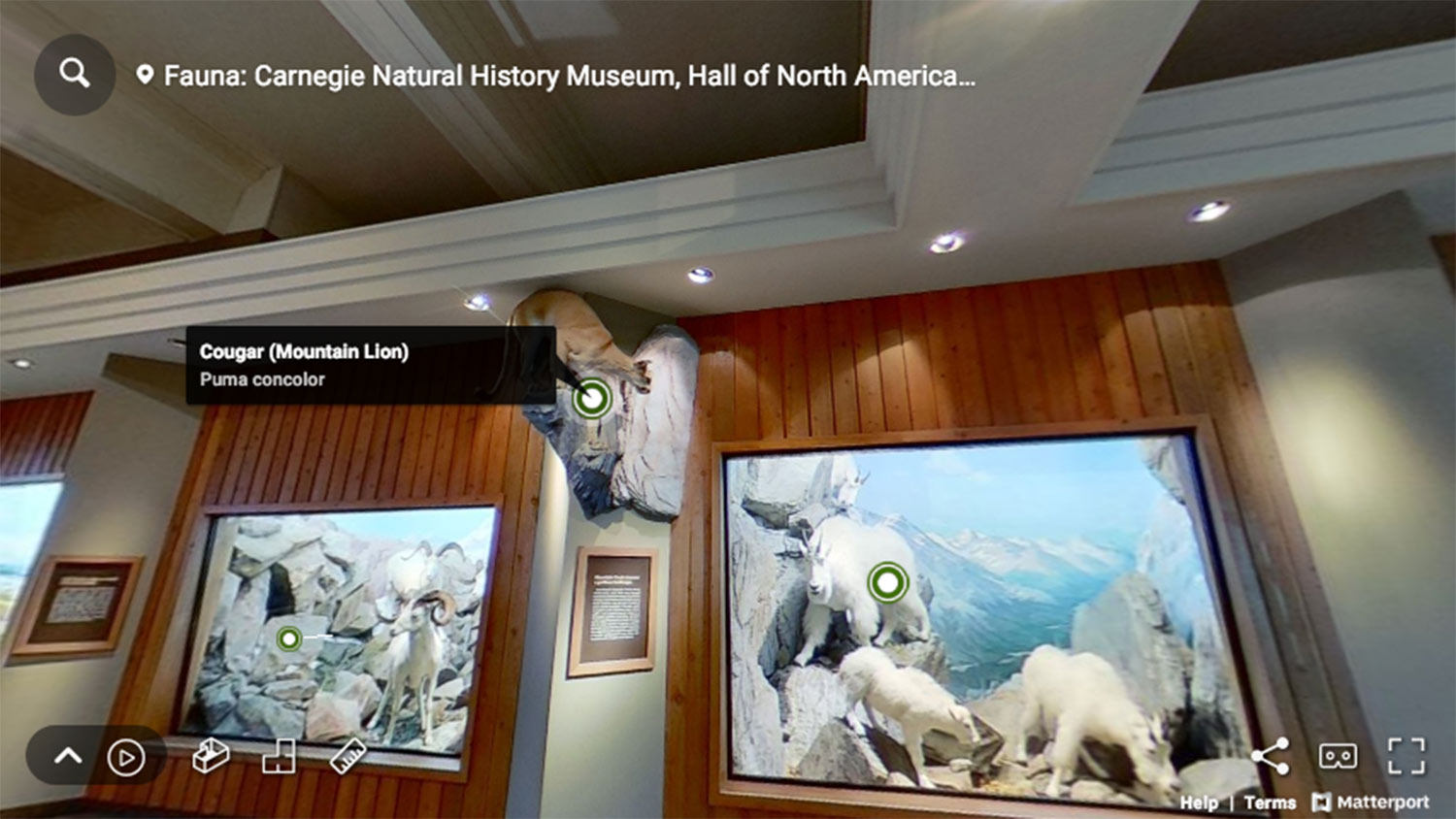
Share This Article
Leave a comment cancel reply.
Your email address will not be published. Required fields are marked *
This site uses Akismet to reduce spam. Learn how your comment data is processed .
Posts by Shaun Slifer
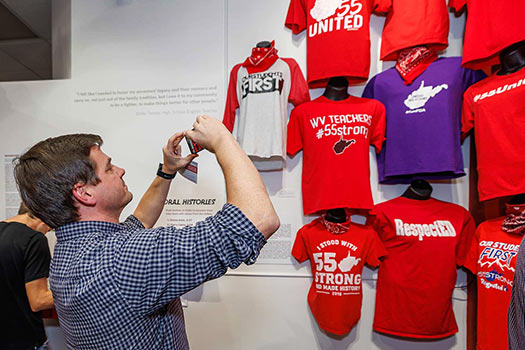
Building an Exhibit on Recent Teacher’s Strikes in West Virginia
“We were still educating. We were showing our kids how to stand up for themselves to a bully.”
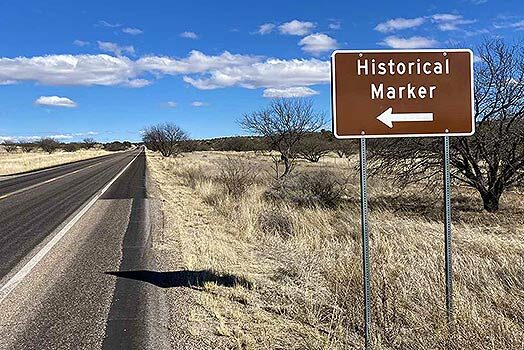
Making Redacted Rubbings in Southeastern Arizona
If “the strike was broken” every time you read about a worker’s struggle that happened on the soil you’re standing on, you might begin to think that every strike has always been broken, and the horizon of collective action and potential for true solidarity might seem like an ideological fantasy…

Courage in the Hollers: New Video + Interview in Jacobin
The West Virginia Mine Wars Museum just dropped this video documenting their new project creating two public monuments to the Battle of Blair Mountain!
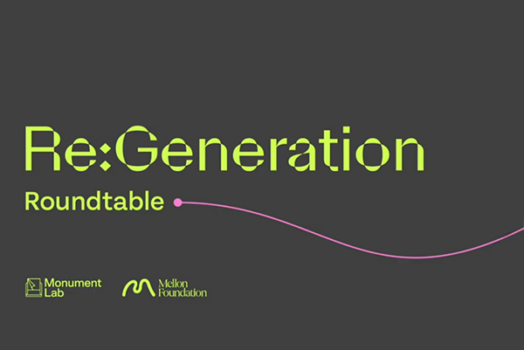
Monument Lab’s Re:Generation Roundtable ft. Shaun Slifer
Mercedes Dorame, Tomiko Meeks, Andrea Roberts, and Justseeds’ own Shaun Slifer discuss their public memory work…
More By Shaun Slifer
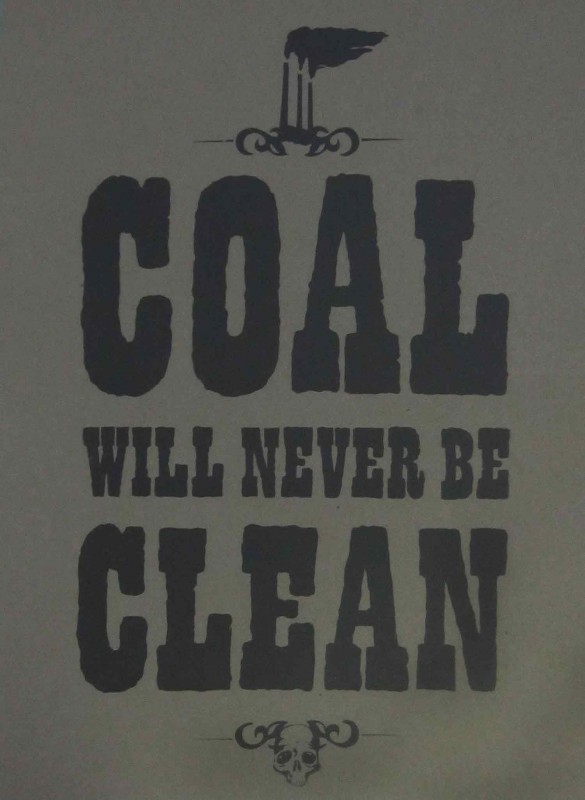
Coal Will Never Be Clean
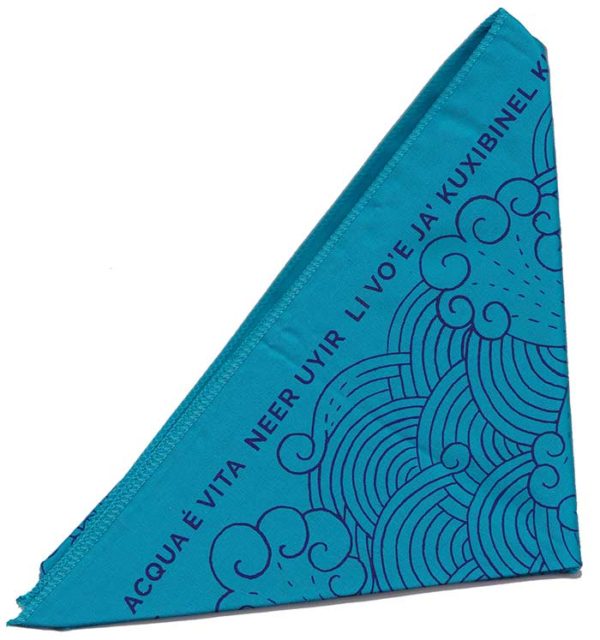
Water is Life Bandana
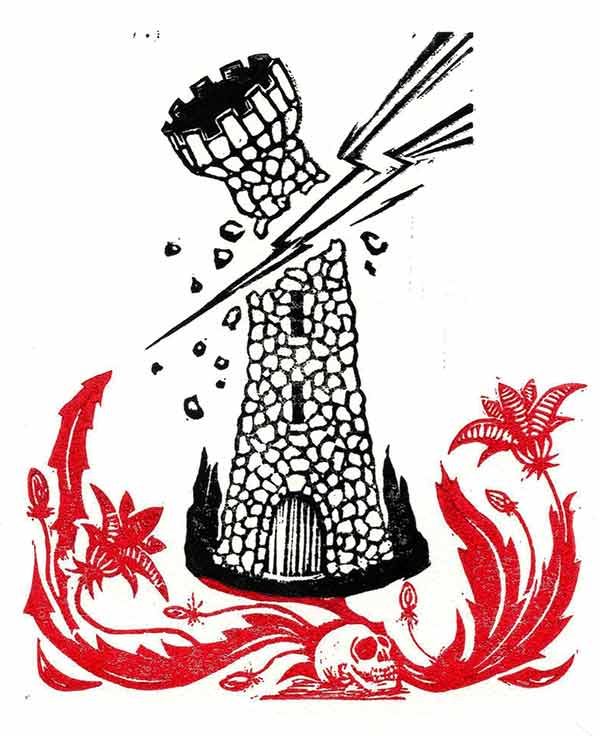
I Believe in Ghosts
Justseeds commits to the international call for boycott, divestment and sanctions (bds) and the palestinian academic and cultural boycott of israel (pacbi).
Virtual Field Trips
Image gallery.
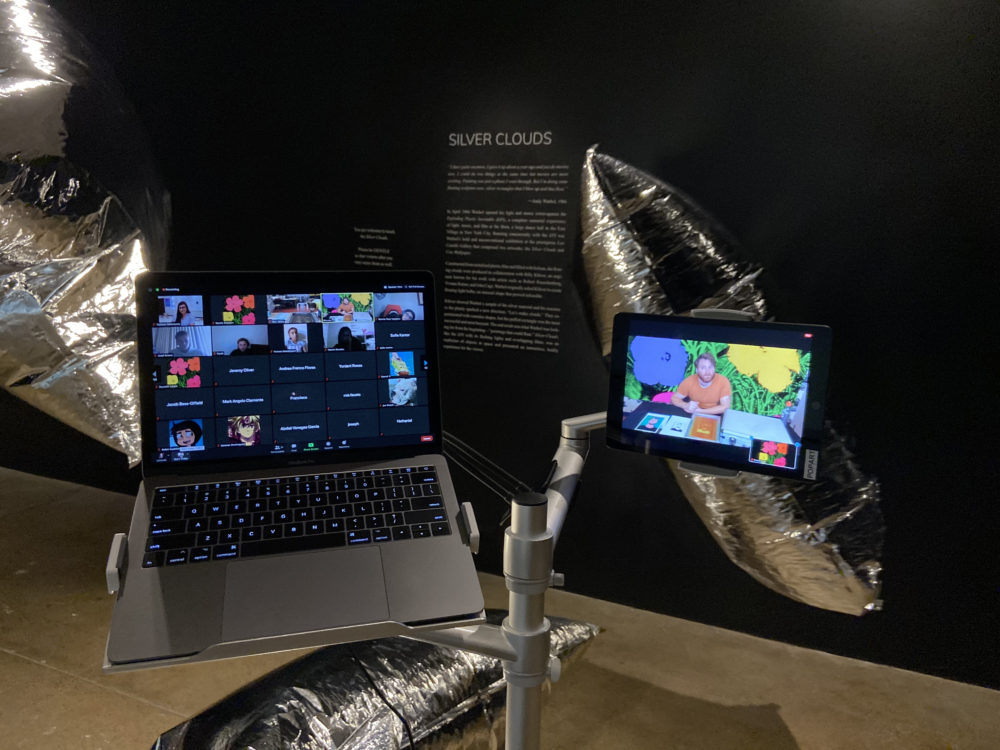
Experience The Warhol from your home or classroom! Through live videoconferencing, participants can digitally experience works of art in our galleries, watch presentations, and share in two-way conversations with museum educators.
A minimum of two weeks advance notice is required for Virtual Field Trips. Programs last 60 minutes and are available during museum hours (Eastern Time Zone).
Technology Requirements
Connect with us through Zoom, Teams, or any other web-based virtual platform. This requires a computer with a reliable internet connection, webcam, microphone, and speakers. A digital projector, large monitor, or smartboard is recommended if you would like to display the experience in the classroom.
Test calls with the museum are strongly recommended employing the equipment and platform you will be using the day of your visit.
$100 for K-12 School/Home School Groups, Community-based/Non-profit organizations, and Families
Customized virtual learning experiences for adults, corporate groups, and professional conferences are also available on a sliding scale. Please contact [email protected] for additional information and to schedule a program.
- Admission + Hours
- Visiting the Museum
- Accessibility
- The Warhol Store
- Exhibitions
- Sound Series
- Andy Warhol
- Film + Video
- Archives + Research
- Publications
- Educators + Schools
- Lessons + Resources
- Community + Outreach
- About the Museum
The Pop District
- Careers + Internships
- Join + Give
- thepopdistrict.org
- The Warhol Creative
- The Warhol Academy
Exhibitions and Events
Art and artist, educators and families.
The Carnegie Heritage Center
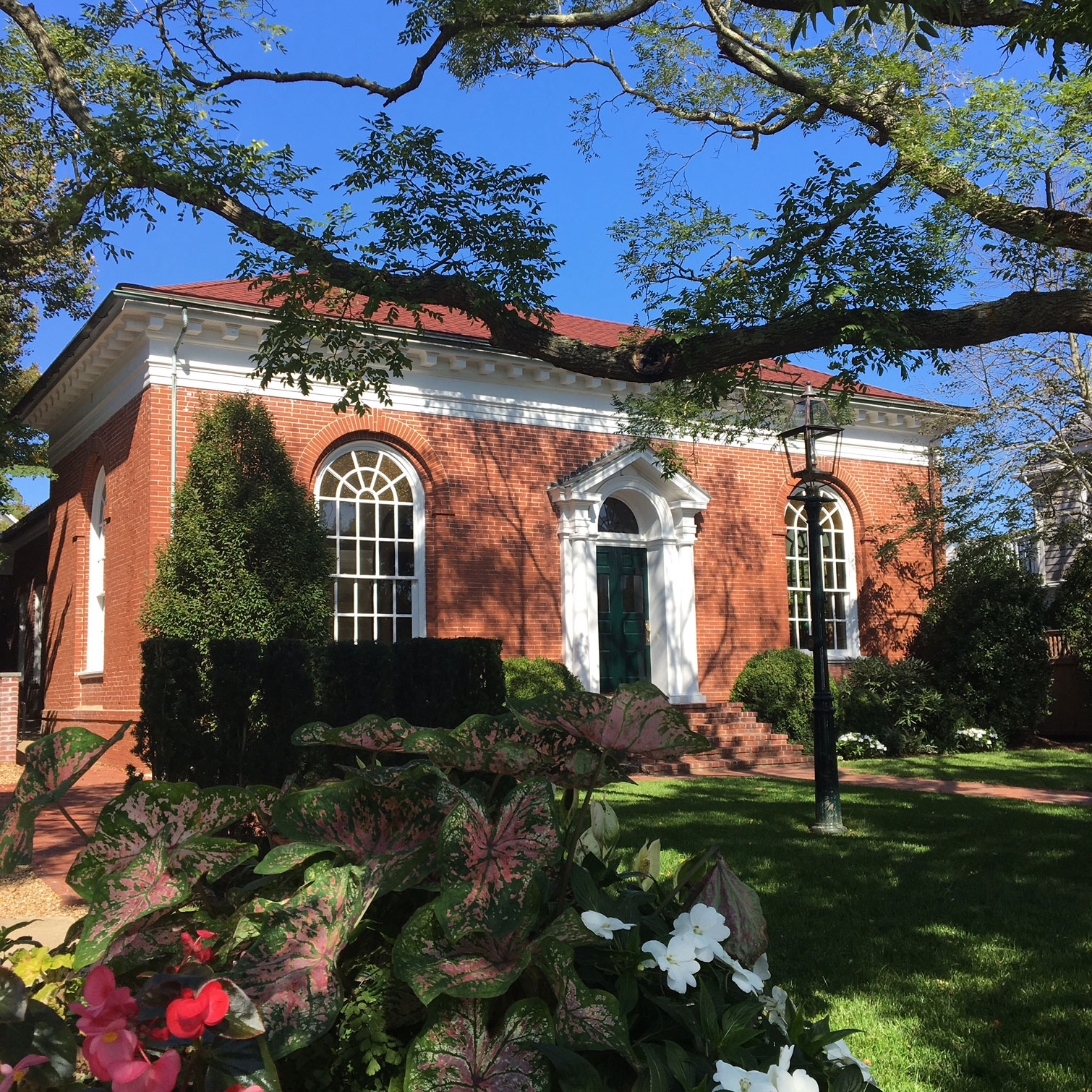
The Carnegie Library building was a gift to the town from Andrew Carnegie, among the more than 2,500 libraries he funded worldwide. The brick building was constructed in 1904 on land donated by Caroline Osborn Warren, a descendant of the Edgartown Osborn whaling family who lived next door. The handsome Neoclassical structure served as the town library from 1904 until 2016, when a newer, larger public library building was constructed on another site.
After an extensive restoration, the Vineyard Preservation Trust reopened the landmark and transformed the space into an island Heritage Center. Inside offers a reading library, heritage shop, and a dynamic revolving exhibit, Living Landmarks , which illustrates the historical development of Martha’s Vineyard through the lens of the landmarks in Vineyard Preservation Trust’s care.
Architectural Gems
Constructed in 1904 by island contractor William King, the Carnegie was funded by a grant of $4,000 by industrialist Andrew Carnegie of Pittsburg and stands on a lot donated by island resident Caroline F. Warner. The original portion of the building consisted of two reading rooms, a circulation desk, and a small storage room where books were stacked. The handsome brick building was designed in the Neoclassical Revival style and includes many features inspired by ancient Greek and Roman architecture.
Neoclassical Revival became a dominant style nationwide between 1900 and 1940. It was directly inspired by the Beaux-Arts style and the Columbian Exposition (Chicago World’s Fair, 1893). The style tends to include the features of classical symmetry, a full-height porch with columns and a temple front, and various classical ornaments such as dentil cornices. Neoclassical Revival spread prolifically throughout the U.S. and became popular for a wide range of everyday buildings. Everything from townhouses, suburban homes, county courthouses, main street commercial buildings, and bank branches readily employed style variations. Elements of the Neoclassical Revival are evident on the Carnegie, including an elevated water table, central entrance with engaged Doric columns supporting a triangular pediment, arched windows and an arched fanlight above the door, brick lintels and keystones, dentil moldings at the cornice, and a hipped roof. The interior rooms in the original portion of the building include arched doorways.
Mr. Carnegie didn’t ask for his name to be emblazoned over the entrance to the library or inscribed on a plaque inside, yet he is honored symbolically in the building itself. One of Carnegie’s favorite symbols was the rising sun, which expressed his belief that the public library embodied the dawn of knowledge. That symbol can be found in the detail of the large windows at the front of the building – a hidden homage to the man who made this building possible.
Island Life
Were you able to go back to the first day The Carnegie opened its doors as a public library in 1904, you might be surprised to find that patronizing a library was very different compared to how these institutions function today. Upon entering the library door, visitors in 1904 would have found themselves in a central foyer with a reading room at either side. The reading rooms were furnished with tables and chairs. In the corner, one might find a display of current periodicals, trade journals, and daily newspapers. The lower portion of the walls was lined with shelving that held a variety of books – popular novels, reference and history books, instructional materials, children’s chapter books, the work of ancient philosophers and important contemporary thinkers, volumes of poetry, and timeless novels by revered writers. The scent of paper and leather bindings was no doubt tempting to bibliophiles. However, library patrons could not independently browse the collection or remove books from the stacks. Instead, clients were requested to proceed to the librarian’s desk at the rear of the building. There, one would speak with the librarian to request a book and, if the requested materials seemed appropriate both in content and reading level for the patron, the librarian would retrieve the volume for the visitor. Should a patron be unsure about what they wanted to read, the librarian helped the individual select a book based upon the person’s interests and taste. In this way, the library collections were carefully tended and patrons received tailored recommendations that were singularly suited to them. Public libraries continue to be an essential part of our communities. They provide access to personal enrichment and educational growth, as a forum for community debate, and ensure free access to important resources.
Faith & Inspiration
“It was from my own early experience that I decided there was no use to which money could be applied so productively… as the founding of a public library… Whatever agencies for good may rise or fall in the future, it seems certain that the Free Library is destined to stand and become a never-ceasing foundation of good to all the inhabitants.” ~ Andrew Carnegie
Andrew Carnegie’s philanthropic career began around 1870. Although he supported myriad projects and causes, he is best known for his gifts of free public library buildings, beginning in his native Dunfermline, Scotland, and ultimately extending throughout the English-speaking world, including the United States, United Kingdom, Australia, and New Zealand. In 1887, Carnegie married Louise Whitfield of New York City. She supported his philanthropy and signed a prenuptial marriage agreement stating Carnegie’s intention of giving away virtually his entire fortune during his lifetime. Two years later, he wrote The Gospel of Wealth, which boldly articulated his view of the rich as trustees of their wealth who should live without extravagance, provide moderately for their families, and use their riches to promote the welfare and happiness of others.
One of the most tangible examples of Andrew Carnegie’s philanthropy was the founding of 2,509 libraries in the late 19th and early 20th centuries. Of these libraries, 1,679 were built in the United States. Carnegie spent over $55 million of his wealth on libraries alone, and he is often referred to as the “Patron Saint of Libraries.”
Carnegie had two main reasons for supporting libraries. First, he believed that in America, anyone with access to books and the desire to learn could educate him- or herself and be successful, as he had been. Second, Carnegie, an immigrant, felt America’s newcomers needed to acquire cultural knowledge of the country, which a library would help make possible. Carnegie indicated it was the first reason that mattered most to him. Growing up working long hours in Pittsburgh, he had no access to formal education. However, a retired merchant, Colonel Anderson, loaned books from his small library to local boys, including Carnegie. As he later wrote in praise of Anderson, “This is but a slight tribute and gives only a faint idea of the depth of gratitude which I feel for what he did for me and my companions. From my own early experience, I decided there was no use to which money could be applied so productive of good to boys and girls who have good within them and ability and ambition to develop it, as the founding of a public library in a community.”
Connect with this landmark
HOURS: Tuesday-Saturday, 10:00am-4:00pm; Sunday (July + August): 12:00-4:00pm
Historic Walking Tours:
- Tour time: 10:30 am
- Daily Tuesday-Saturday starting June 4th- August 31st
- Location: The Old Whaling Church, 89 Main Street, Edgartown
- Phone: 774-549-9107
- Time: 75 Minutes (walking), Rain or Shine
- Guests per group: 14
Tickets : $25- Adult, $10 Youth (6-17), Under 6 Free. – Gratuities for guide appreciated
Tour Tickets
Are you interested in a private tour?
Inquire about Private Tours Here
The Carnegie is a magical place for your next cocktail party or corporate event.
Rent The Carnegie
Living Landmarks Exhibition
The Carnegie houses the permanent exhibition Living Landmarks , which illustrates the story of Martha’s Vineyard through the lens of the 20 landmarks in Vineyard Preservation Trust’s care.
There is a $5 suggested donation to view the Living Landmarks exhibition.
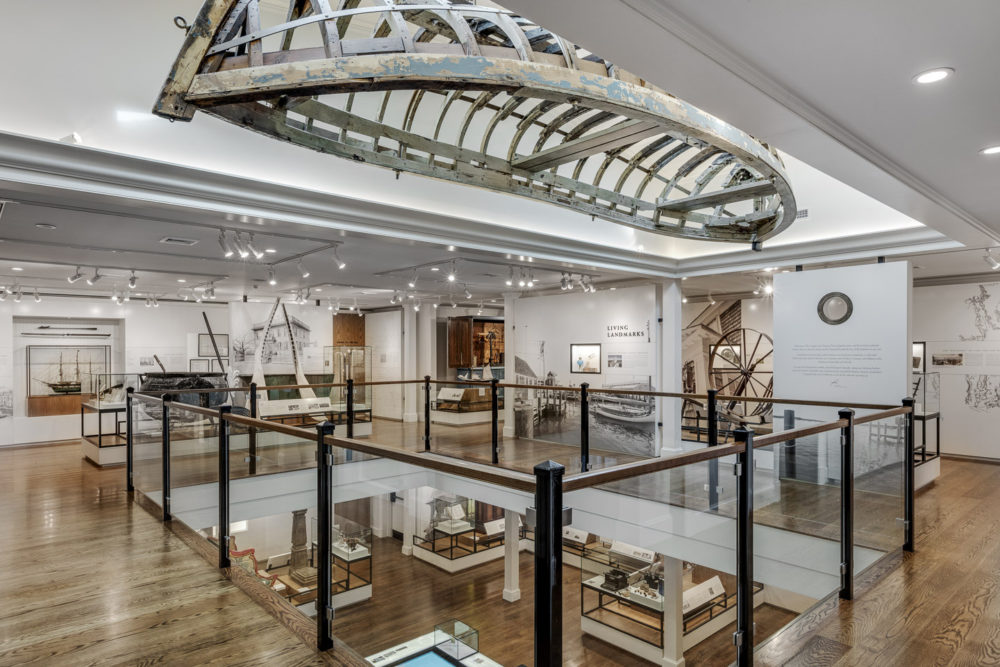
Reading Rooms
The Carnegie includes two reading rooms featuring historical and maritime literature and the Ray Ellis Maritime Collection of original art.
The light-filled furnished spaces also include cabinets of curiosities that reflect the inspiring people, places, and landscapes that dynamically contribute to island life.
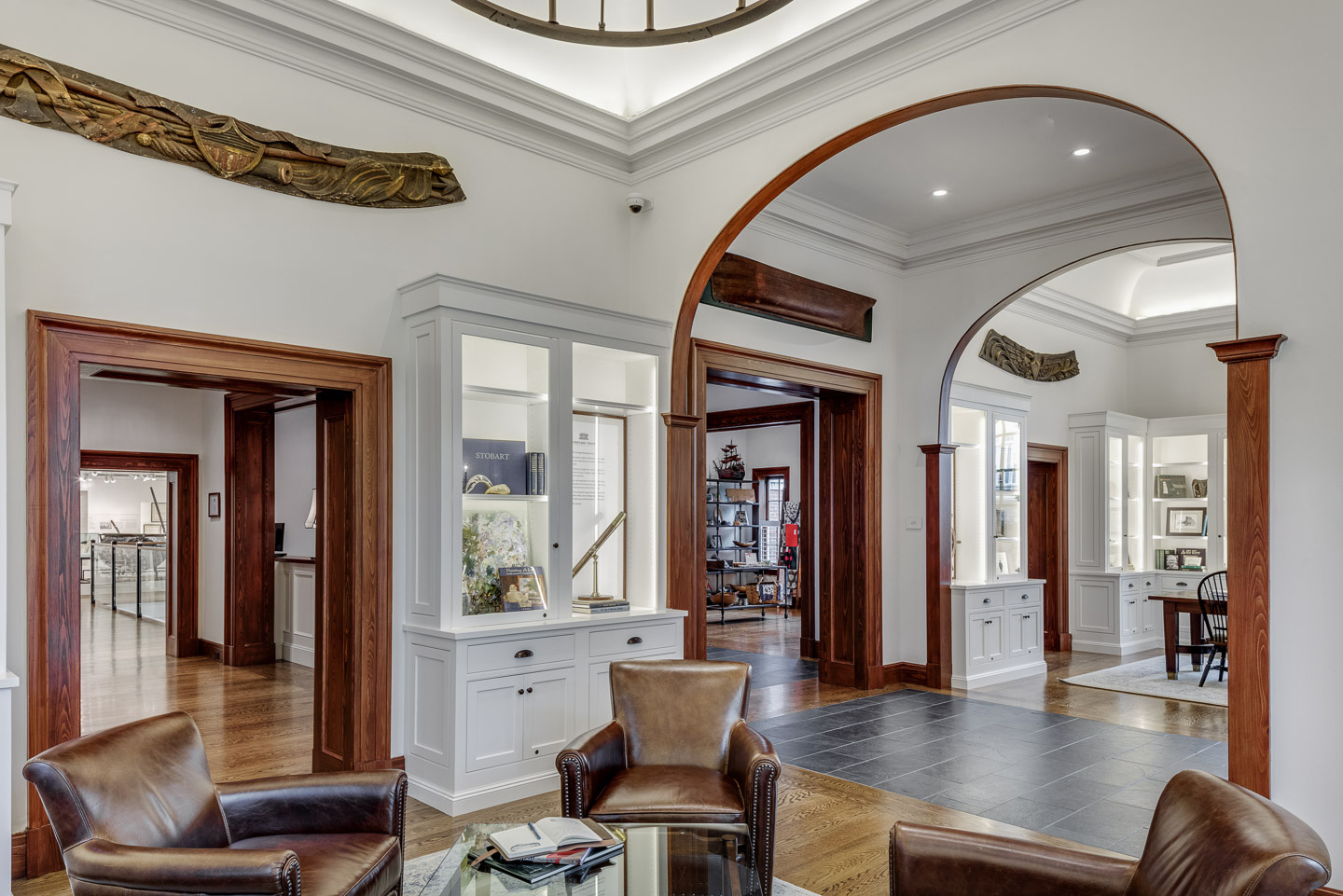
Buy A Brick
Support the preservation of The Carnegie by purchasing a brick for the front walkway.
Each brick can be inscribed with an individual, family, or organization name of your choice.
$1,000 per brick Buy A Brick!
Questions: please contact The Carnegie [email protected]
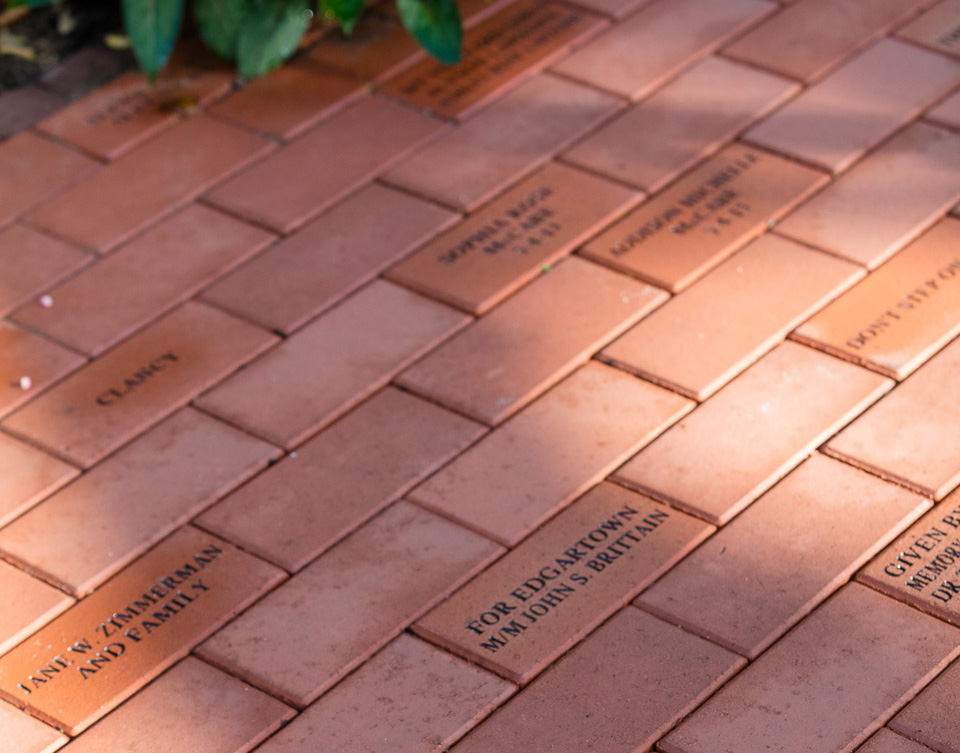
Events At The Carnegie

Accept cookies?
We use cook ies to give you the best online experience and to show personalised content and marketing. We use them to improve our website and content as well as to tailor our digital advertising on third-party platforms. You can change your preferences at any time.
Popular search terms:
- British wildlife
- Wildlife Photographer of the Year
- Explore the Museum
Virtual Museum: 13 ways to explore from home
Delve into the Museum from home with a virtual self-guided tour of the galleries, an interactive experience about Hope the blue whale and audio guides narrated by Sir David Attenborough.
1. Stroll around the Fantastic Beasts™: The Wonder of Nature exhibition
Although the exhibition at the Museum closed on 3 January 2022, you can still step into an online world full of fantastic real-life and magical beasts. There are highlights, stories and games galore.
Walk around the exhibition from home with a 360° virtual tour on Google Arts & Culture.
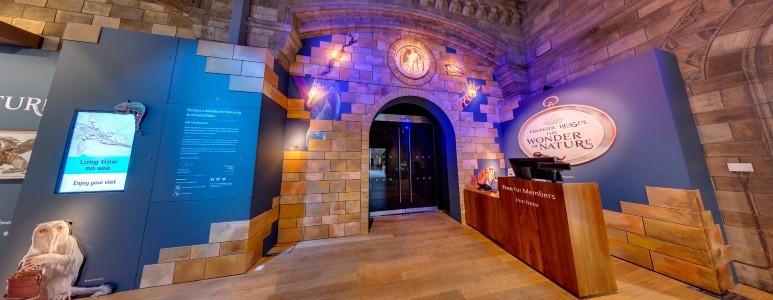
2. Take a deep dive into the life of a blue whale
Explore the rich history of Hope, the blue whale suspended from the ceiling in Hintze Hall. In this online interactive, see what her life was like in the ocean, find out how she got to her home in the Museum and get a behind-the-scenes peek of the Museum's collections.
Go one step further by viewing the skeleton in augmented reality (AR) with Google Arts & Culture.
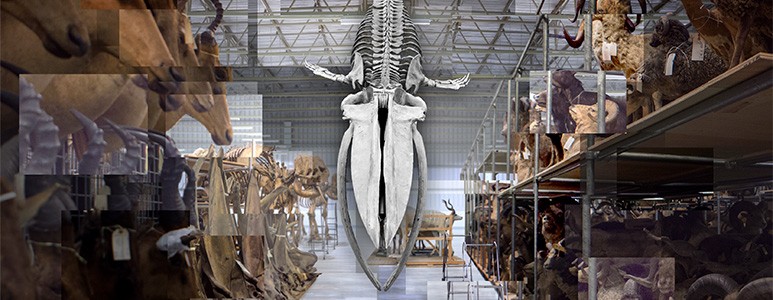

3. Hang out with scientists online
Catch up on all the Nature Live Online talks featuring topical discussions with our scientists and cutting-edge research.
Free event recordings.

Image: NASA .
4. Sound choices: listen to these podcasts
Every year the Museum attracts millions of curious visitors eager to learn about the natural world.
Bring that curiosity home, and learn more about natural history, science, and the world around you with these great podcasts.
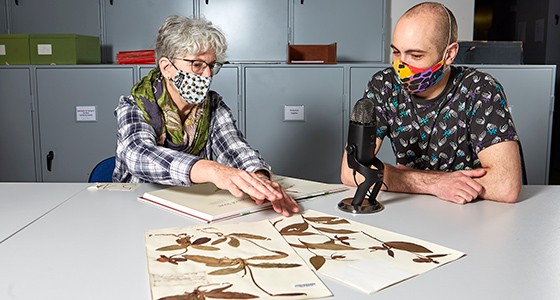
5. Let Sir David Attenborough guide you around Hintze Hall
Sir David's unmistakable voice and expertise on all things nature make him the perfect person to take you on a tour of Hintze Hall's star specimens (including the blue marlin), all from the comfort of home.
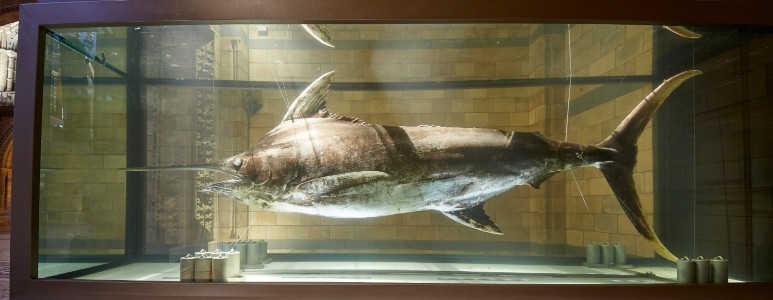
6. Go on a virtual tour of the Museum
Google Arts & Culture gives you access to 300,000 specimens within the Museum's collections, along with 35 digital exhibitions , virtual tours and an interactive gigapixel photo (so enormous you can zoom in on the tiniest detail) of Hintze Hall's gilded canopy.
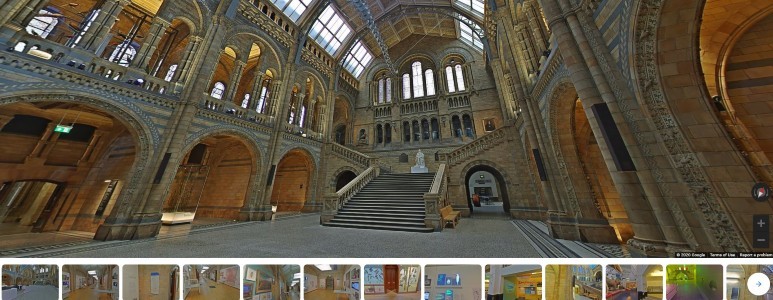
7. Flick through Wildlife Photographer of the Year images
Explore the exhibition at your own pace in this online gallery filled with stunning nature photographs.
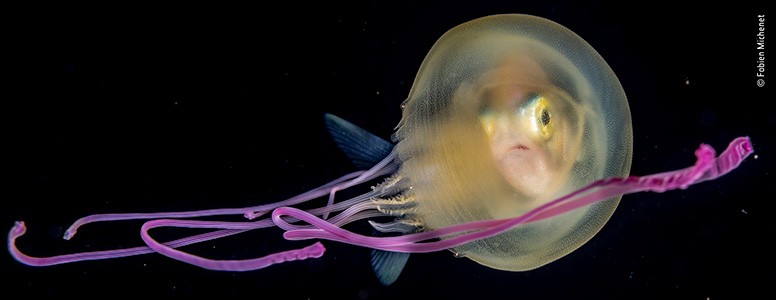
8. Watch us on the small screen
The Museum's stunning architecture has made it a popular choice as a filming location for everything from blockbuster movies to TV dramas.
Discover which films and television shows feature the Museum.
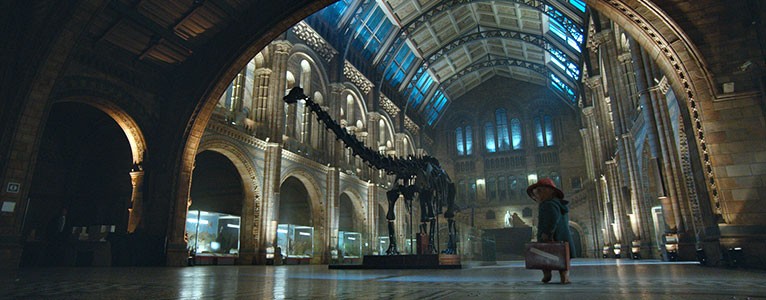
Paddington (2014)
9. Examine a 3D model of Dippy's skull
Get up close to the skull of the Museum's iconic Diplodocus cast produced by our Imaging and Analysis Centre. See more 3D models on Sketchfab , including Darwin's fossil mammals and the Crystal Palace sculptures .
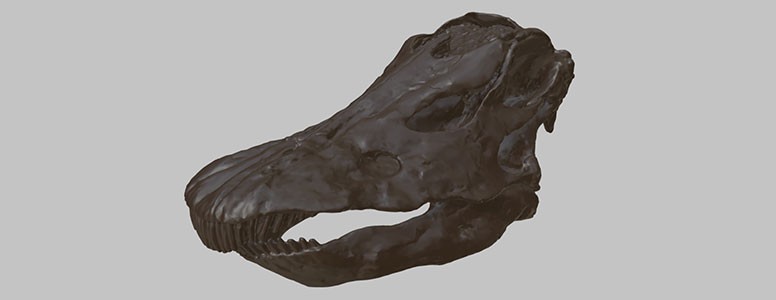
10. See illustrations from HMS Endeavour
Our collection of botanical illustrations from HMS Endeavour make up some of the most scientifically significant artworks in our archive. It features works by Sydney Parkinson .
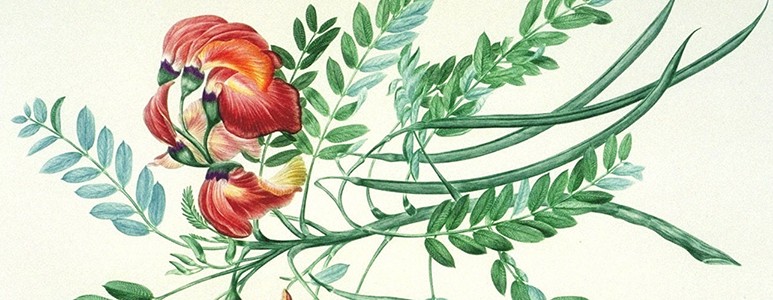
11. Browse the Library and Archives digital collections
Dig deep into the archives, where you'll find scientifically important art, books, prints and manuscripts, including drawings by William Smith and brothers Franz and Ferdinand Bauer.
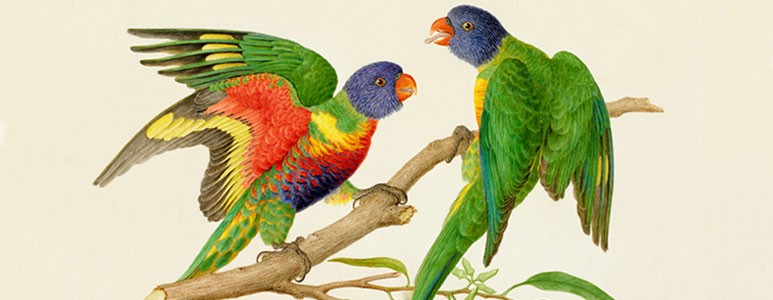
12. Uncover highlights from the collections
We've wrapped up some of the highlights from the collections on display including specimens from space , the spirit collection , Charles Darwin and the Treasures gallery .
Discover more stories from the collections including stories from the Museum at Tring .
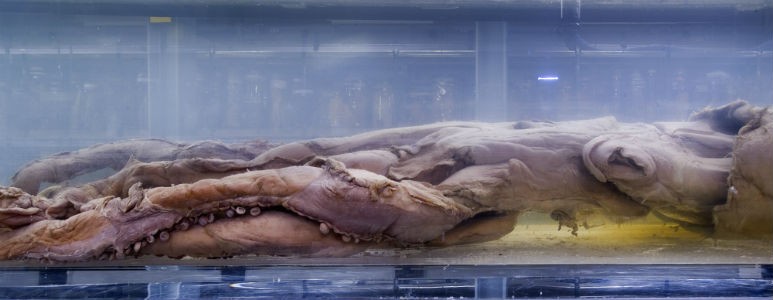
13. Zoom in on beetles
Open the drawers and zoom in on 16 Coleoptera collections held at the Museum including those from Thomas Broun (1838-1919), David Sharp (1840-1922) and Charles O. Waterhouse (1843-1917).
Find out more about the Entomology collections .

Virtual expeditions with our scientists
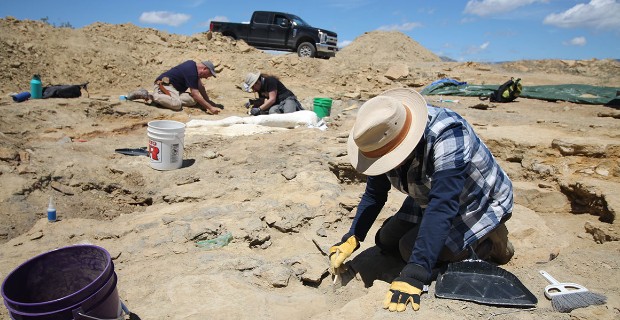
What is it like to go on a dino dig?
Explore an interactive story about Museum experts' adventure to Wyoming, USA, when they went off-grid in search of Jurassic dinosaurs.

Explore a 360 panorama of Antarctica
Join Dr Adrian Glover as he journeys to the site of a collapsed Antarctic ice shelf. Experience the awe-inspiring view from the ship deck.
Let the exploration continue
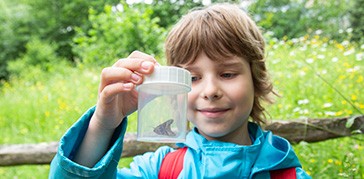
Enjoy nature on your doorstep
Find activities and ideas to occupy yourself and family at home, in your garden or local outdoor space.
Try this at home
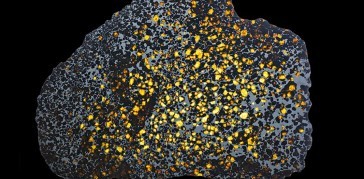
Discover more stories from the collections
Uncover colourful stories behind the specimens, meet collectors and curators past and present and read about their contributions to our understanding of the natural world.

Teaching resources
A range of downloadable educational curriculum-linked resources that you can adapt for home use.
Find out more
Don't miss a thing.
Receive email updates about our news, science, exhibitions, events, products, services and fundraising activities. We may occasionally include third-party content from our corporate partners and other museums. We will not share your personal details with these third parties. You must be over the age of 13. Privacy notice .
Follow us on social media
- Proceedings
- Well Played Advisory
- Well Played Style
- Latest News
- About ETC Press
- ETC Press Advisory
- Proposal Guidelines
- Book Proposal Guide
- Singles Proposal Guide
- Manuscript Style
- Frequently-Asked Questions

Playful Testing
Designing a formative assessment game for data science.
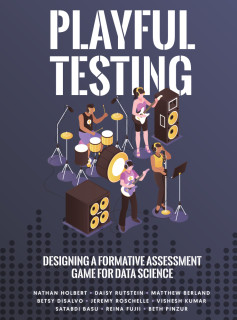
In this volume, an interdisciplinary team of researchers shares insights from three years of intensive design research resulting in a game for assessment of computer science and data science skills. The context, grounded in New York City public schools and the needs of middle school students and teachers, set a challenging innovation agenda. Beats Empire, the formative assessment game designed in response to these challenges, quickly garnered many awards and downloads.
The game offers each student an opportunity to manage recording artists, shaping the parameters of their recordings in response to their analysis of song trends in an imaginary metropolis. The learning and assessment themes align to a national computer science framework; the topics of data collection, storage, visualization and interpretation are key data science skills that are relevant across many subjects, such as math, science, and social studies. Game play maps realistically onto how today’s music industry producers and managers use data to increase their artists’ followers, listens, and sales.
This book follows the team through the initial design process, the development of the game, its implementation in a middle school classroom, the research that came from game data, and reflections on lessons learned and future directions. By explaining in detail the team’s game design process, and connecting this account to prior research on game and assessment design, this book offers important insights into the design of assessment games.
Copyright © 2024 Carnegie Mellon University. All Rights Reserved | Legal | Login
- Accessibility
- Departments
- ConnectCarolina
Hannibal Albert Davis
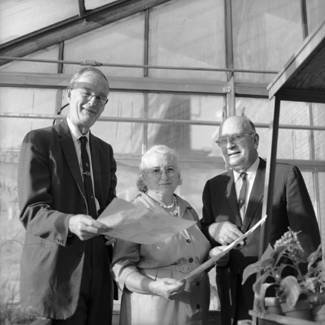
(August 1, 1899 – May 28, 1992)
The University of North Carolina at Chapel Hil Herbarium (NCU) has cataloged approximately 40 specimens collected by Hannibal Albert Davis and his spouse, Tyreeca Stemple Davis. No doubt more will be found as cataloging continues. The Davises usually signed their specimens “Mr. and Mrs. H.A. Davis.” The Davises collected many specimens for distribution in the Southern Appalachian Botanical Club’s series of exsiccati.
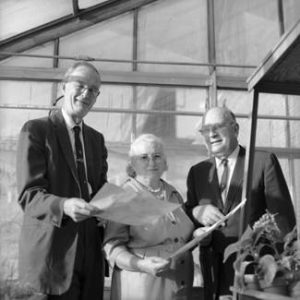
Hannibal Albert Davis was born in Marshall County, West Virginia. He earned both A. B. and M.A. degrees in mathematics from West Virginia University. Upon completion of Ph.D. in mathematics from Cornell University in 1928, he joined the mathematics faculty West Virginia University in Morgantown, WV, and served as that department’s head from 1948-1960. Upon retirement, the Davises moved to Freeport, Florida (ca. 1982).
Davis’ botanical interests included Rubus and Viola . Rubus leggii was named by H. A. and Tyreeca Davis in William Clarence Legg’s honor (Davis, H.A. and Tyreeca Davis. 1953. The genus Rubus in West Virginia. CASTANEA 18(1): 1-31). “This species is dedicated to the memory of the late William C. Legg, naturalist of Mount Lookout, Nicholas County, West Virginia, whom we accompanied on several pleasant and profitable field trips” (p. 27-28).
The Harvard Herbaria Database lists CM (Carnegie Museum of Natural History in Pittsburgh, Pennsylvania, USA) as a major repository for Davis’ herbarium specimens, though it seems likely that WVA (West Virginia University in Morgantown, WV, USA) would have many as well.
Dr. Wayne Davis and Dr. Elizabeth Davis Swiger established the H.A. and Tyreeca Davis Herbarium Endowment at WVA in honor and memory of their parents.
Anonymous (1988) Davis Herbarium Goes to Carnegie Museum. CASTANEA 53: 83.
The private herbarium of Hannibal A. and Tyrecca E. Davis has been given to the Carnegie Museum in Pittsburgh. This consists of a 10,000 sheet general collection with emphasis on West Virginia, and 10,000 sheets of Rubus , mostly from eastern North America. The Rubus material is the basis for the Davis’ (with A. M. Fuller) revision of the North American Eubati ( Castanea 1967, 32: 20-37; 1968, 33:50-76; 1969, 34: 157-179; 1969, 34: 235-266; 1970, 35: 176-194; 1982, 47: 216-219). Although it contains no types, this is the most valuable collection extant to use in identifying an unknown specimen. For each species the Davises had a “working type”, usually from the type locality or nearby, which they had carefully compared to the type specimen. For many species names the type is too poor to be recognizable: too immature; floricanes only; primocanes only; parcifronds or novirames; a mixture of more than one species, or other such problems. With considerable effort, often observing at different stages of development and sometimes growing the plants, they were able to prepare good material that they were confident represented the species described.
The Davises visited most of the type localities for North American Rubus names, and their collection contains representatives for nearly all names.
All the Davises’ working materials regarding Rubus (notes made when examining types, manuscripts, correspondence, annotated reprints, etc.) have also been deposited at the Herbarium of the Carnegie Museum.
Partial list of publications:
Davis, Hannibal Albert (1930) Involutorial transformations belonging to a linear complex. Am. J. of Mathematics 52(1): 53-71.
Davis, H.A. and Tyreeca Davis (1953) The genus Rubus in West Virginia. Castanea 18 (1): 1-31.
Core, Earl L. and H.A. Davis (1953) New plant records for West Virginia. Castanea 18 (1): 31.
Davis, H.A., Albert M. Fuller, and Tyreeca Davis (1982) Some comments on Rubus . Castanea 47 (2): 216-219.
Davis, Hannibal A. (1990) Studies in “Rubus .” Castanea 55 (1): 22-30.
Drop-in Tours at CMOA
Take a closer look at the collection with an expert guide.
In the Moment Tours at CMOA
Monthly tours designed especially for those with Alzheimer’s or other forms of dementia and their caregivers.
Gallery Talks at The Warhol
Dig deeper into Andy Warhol’s life and work with these daily, 30-minute talks with educators, including Donald Warhola, one of Andy’s nephews.
- Skip to primary navigation
- Skip to main content
- Skip to primary sidebar
Carnegie Museum of Natural History
One of the Four Carnegie Museums of Pittsburgh
Interpreting Museum Exhibits Virtually
by Patrick McShea
Natural History Interpreters are a corps of educators charged with presenting the museum’s exhibits to audiences in a way that encourages the collective development of emotional and intellectual connections to the topics being discussed. During the past eight months, a small, but growing number of Interpreters have pursued this mission by guiding school groups on virtual tours of Dinosaur Armor .

The visually striking objects in the world premiere exhibition retain much of their captivating power when presented over electronic screens, and cell phone cameras, when paired with hand-held stabilizer units, have proven to be fully capable of live streaming all the required video.
During the recently completed school year 54 virtual tours of Dinosaur Armor reached an estimated student audience of 3,450, with classes in first to fourth grades accounting for the greatest number of those individuals. The geographical reach of the program has been particularly impressive, with schools in 13 states participating.
The Interpreters developed a team-based strategy for delivering their presentations as cohesive interactive lessons. Standard team positions, which rotate as necessary, include a camera operator in the exhibit, an accompanying narrator who occasionally appears on camera, and a director who participates via a computer link to both provide occasional commentary and facilitate communication between the audience, camera operator, and narrator.
According to Interpreter Joann Wilson the development was an easier-said-than-done proposition. “When I started virtual tours, I thought that it would be like my old in-person tour role with a few minor adjustments. How wrong I was! What I have discovered after over 8 months is that although the goal is the same, how we get there is very different.”
On June 8, I had the opportunity to observe a virtual Dinosaur Armor tour for a combined pre-school and kindergarten class. My computer screen displayed the same images the children watched on a large monitor at the front of their classroom. When the colorful image of a frightening looking Eurypterid, or sea scorpion filled the screen, audience excitement was transmitted back to the Interpreter team via the “oohs” and “ahhs” of young voices. Just as the Interpreters would do for any in-person audience, they quickly transformed student curiosity into a learning experience through the careful use of questions.
Students were initially asked to describe what they observed, and their responses (“ The claws are sharp .” “ The eyes are big ovals .”) provided immediate feedback about the clarity of the transmission. In this case the routine compilation of student observations was remarkable because of the distance involved. The pre-school and kindergarten class was in Bali, Indonesia .
As Program Manager Mandi Lyon explains, “It was 9:30 a.m. for us in Pittsburgh, and 9:30 p.m. for them in Bali. They came back to their school in their pjs for a pajama party so they could participate in the tour together.”
In most cases, however, the same COVID-19 restrictions that led to the development of Virtual Tours also placed many students in viewing conditions far less comfortable than the classroom in Bali. Whenever a Virtual Tour served a class in a school operating under a remote learning mandate, the Interpreter team faced the challenge of engaging dozens of students watching separately from their homes.
By supplying teachers with relevant digital resources, including video clips, blog posts, and work sheets, weeks before their students participated in a Virtual Tour, the Interpreters hoped to initiate teaching partnerships that made each live 60-minute program both instructive and enjoyable. The success of such efforts is currently being accessed through the review of post-Virtual Tour evaluations, several of which included heartening testimony. One teacher noted how the virtual tour had expanded the range of possible teaching resources: “I am so excited we had the opportunity to visit through Zoom. After doing this, it seems we could reach so many places and let the students have such a varied experience in the classroom.” Another teacher was particularly pleased with a potential career thread woven into the tour: “The idea of anyone becoming a scientist was evident in your presentation.”
Outside of the formal evaluations, one wholly positive real-time measurement stands out. Several times teachers remarked that students who kept their cameras off though weeks of regular remote classes turned their cameras on to watch and participate in the Virtual Tour.
CMNH Interpreters have also provide Virtual Tours exploring Ecosystems, Ancient Egypt, and Gems and Minerals. Besides Indonesia, other particularly distant schools served by the program were in Qatar, and the U.S. Virgin Islands. Training is currently underway to expand the number of Interpreters who are able to participate on Virtual Tour teams.
The development and implementation of Virtual Tour Program was generously supported with funding from the Buncher Foundation and the Scaife Family Foundation.
Patrick McShea works in the Education and Visitor Experience department of Carnegie Museum of Natural History. Museum employees are encouraged to blog about their unique experiences and knowledge gained from working at the museum.
Related Content
Virtual Field Trips & Activities
Teacher Profile: Emmanuelle Wambach
Alaskan Brown Bears Spotlight (Video)
Carnegie Museum of Natural History Blog Citation Information
Share this post.
- Share on Twitter Share on Twitter
- Share on Facebook Share on Facebook
- Share on Pinterest Share on Pinterest
- Share on LinkedIn Share on LinkedIn
- Share on Reddit Share on Reddit
- Share via Email Share via Email
- Mission & Commitments
- Directors Team
- Museum History
Get Involved
- Carnegie Discoverers
Bring a Group
- Groups of 10 or More
- Birthday Parties at the Museum
- Field Trips
- Powdermill Nature Reserve
- Powdermill Field Trips
- Powdermill Staff
- Research at Powdermill
More Information
- Image Permission Requests
- Accessibility
- Shopping Cart
- Visitor Policies

Widening the Lens Podcast Series

Widening the Lens: Photography, Ecology, and the Contemporary Landscape

Marie Watt: LAND STITCHES WATER SKY
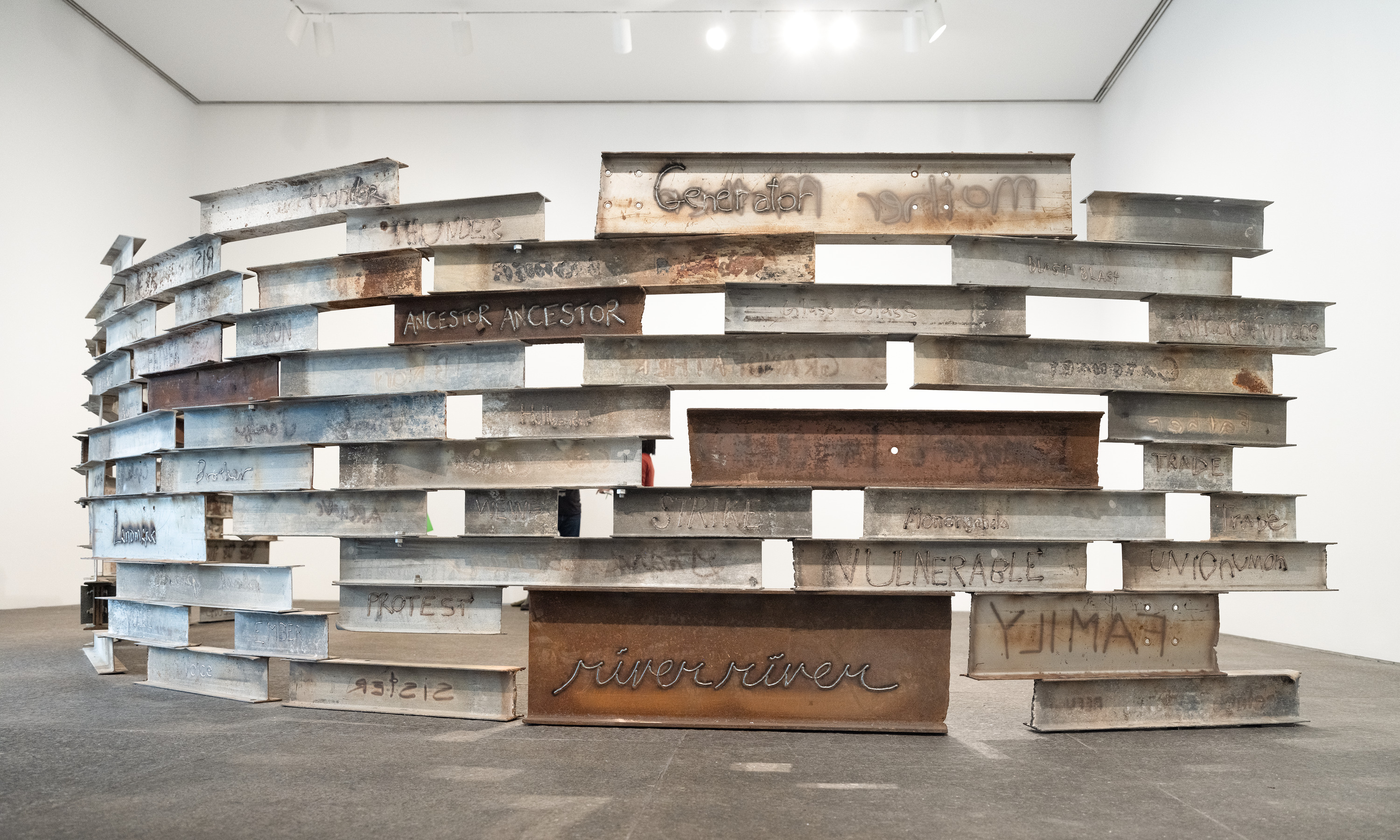
Carnegie Museum of Art Film Series
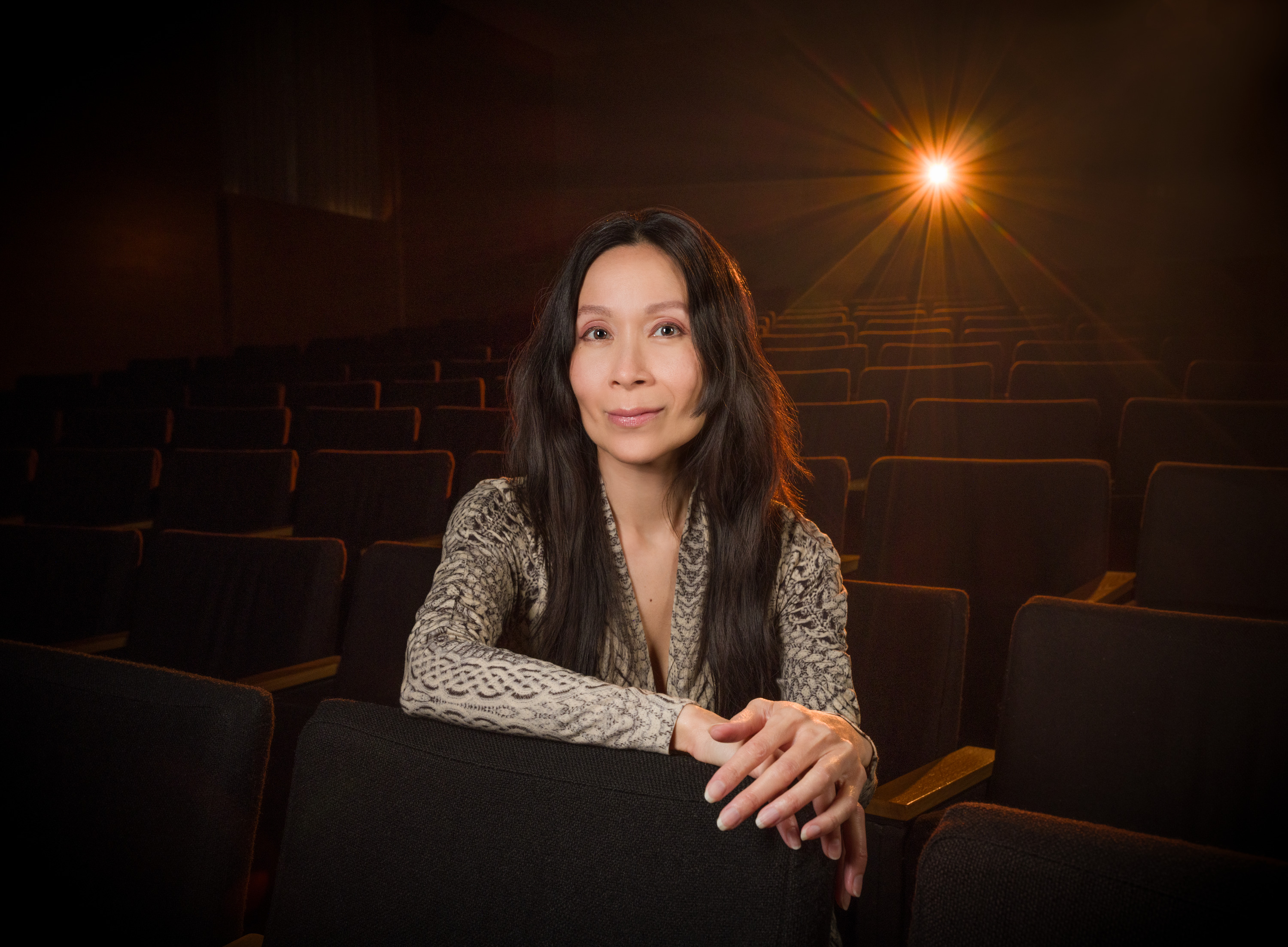
Mindful Museum
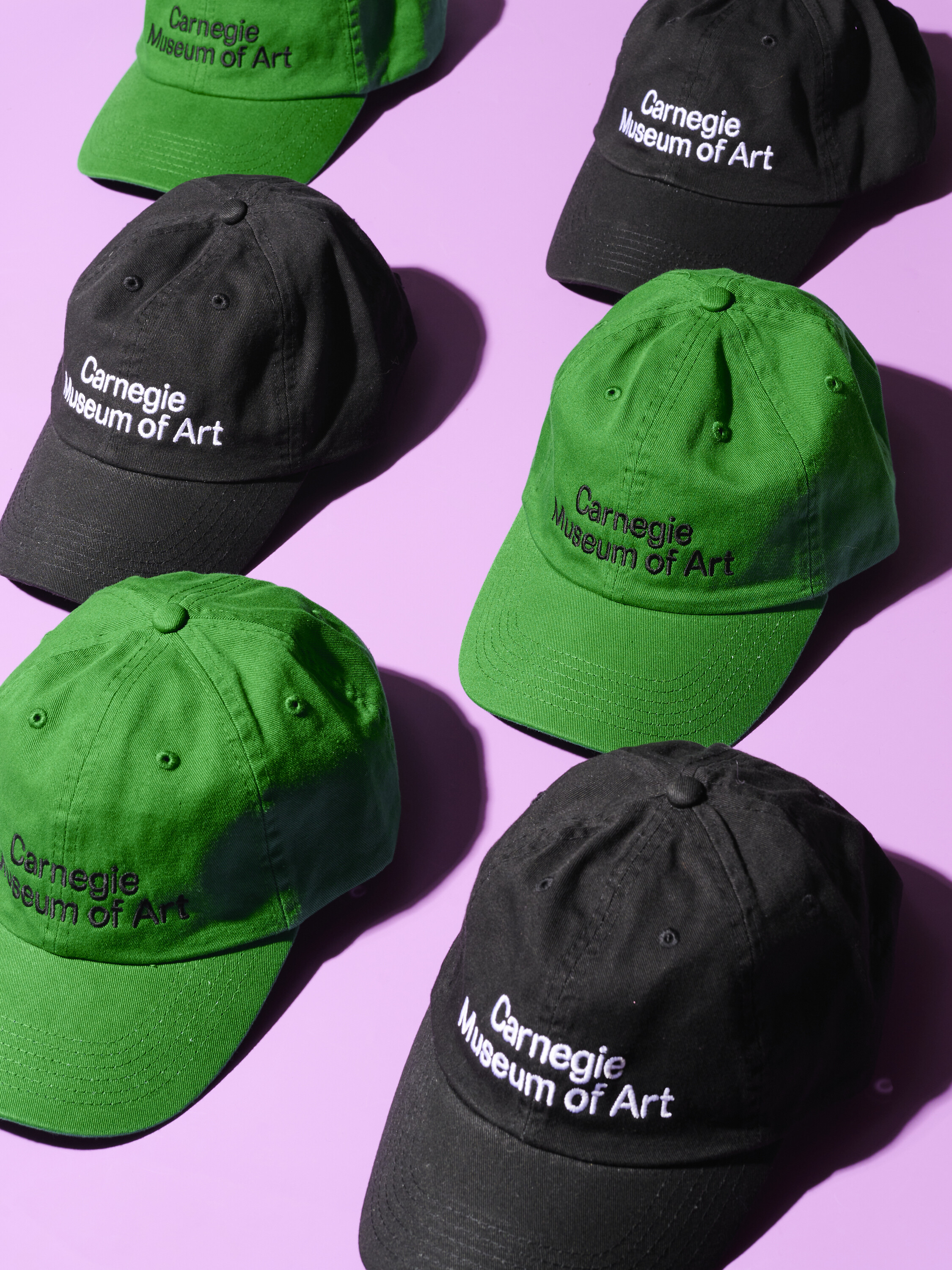
Art to Encounter View All →
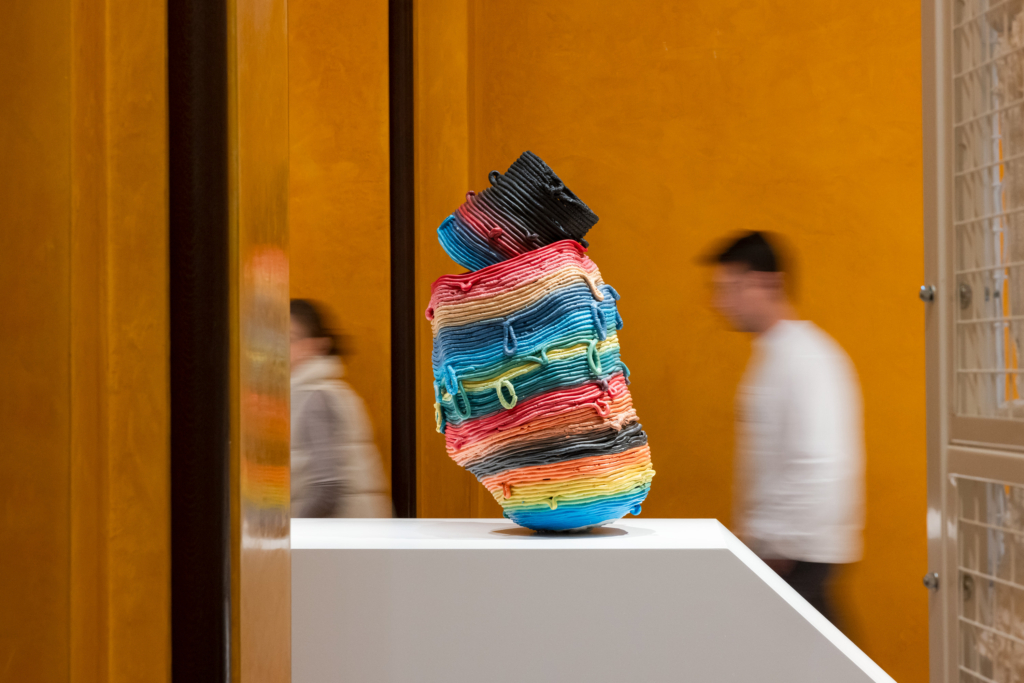
- Heinz Architectural Center
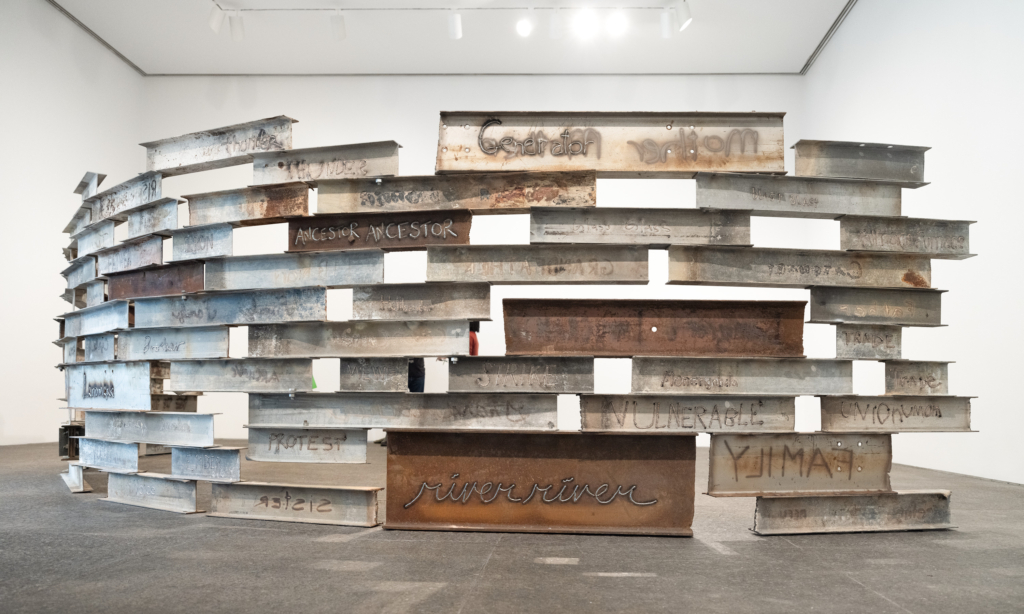
- Forum Gallery
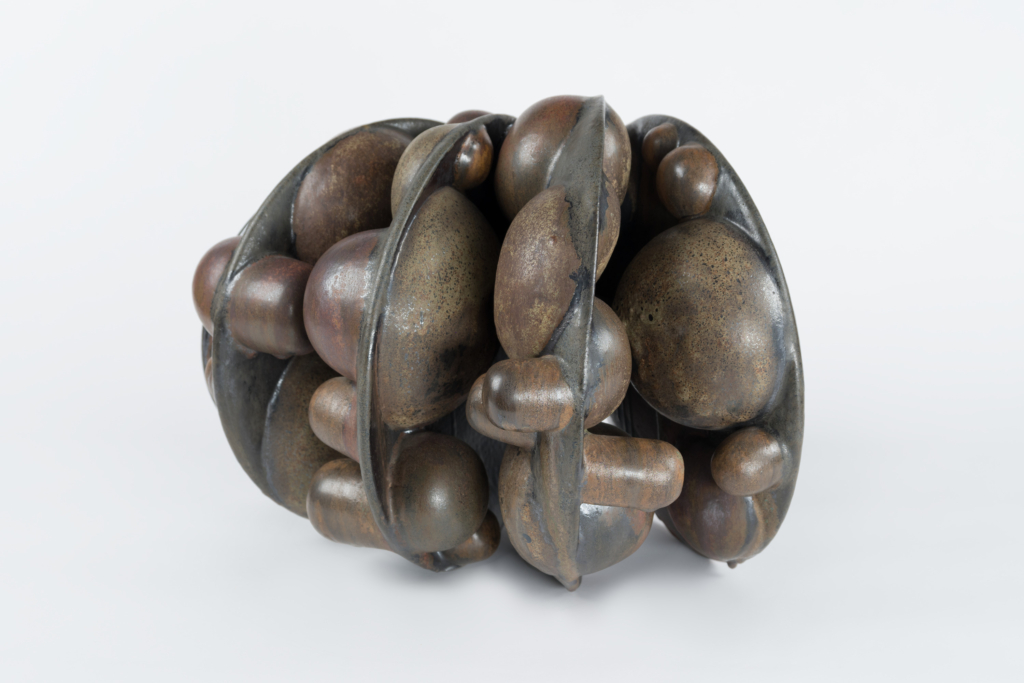
- Scaife Gallery 1
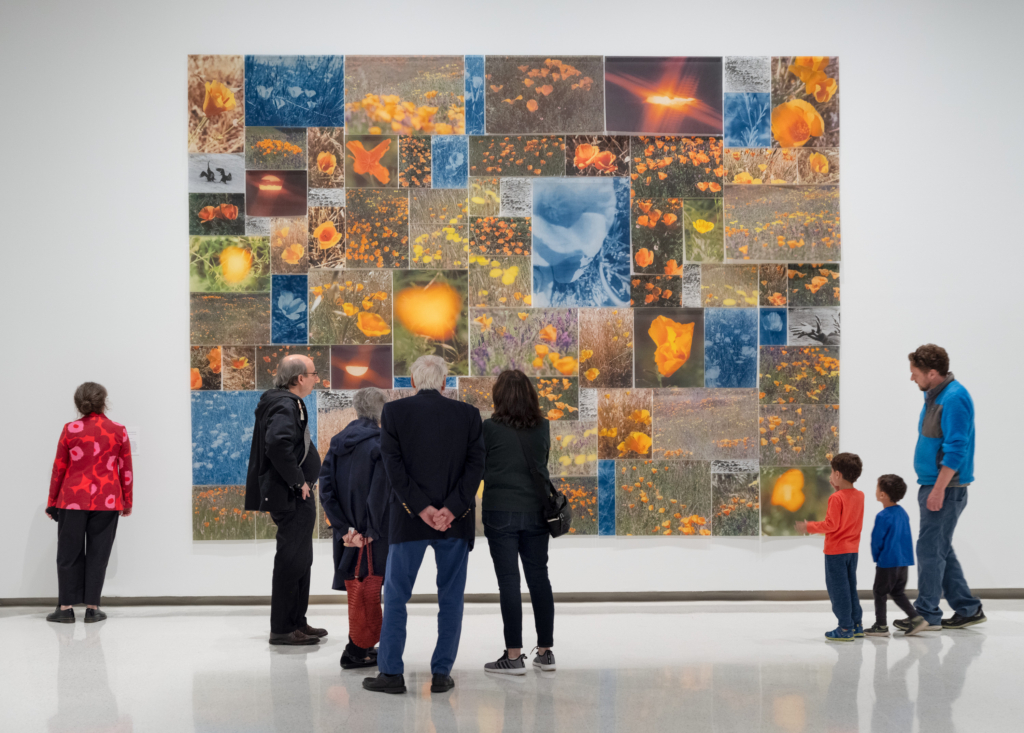
- Heinz Galleries
What’s Happening View All →

Read, Watch, Listen
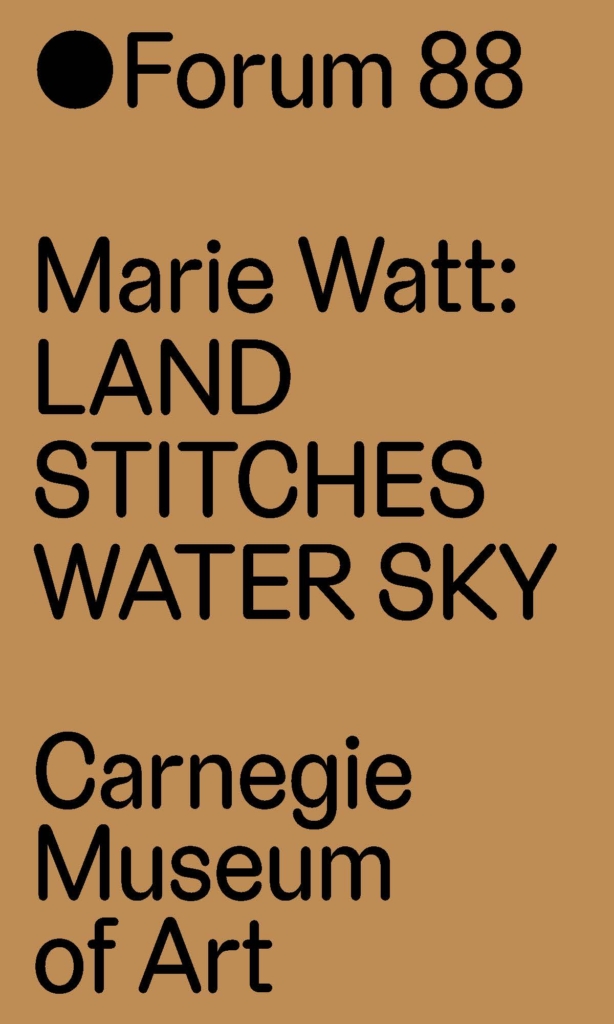
- Exhibition Brochure

Explore the Collection View All →
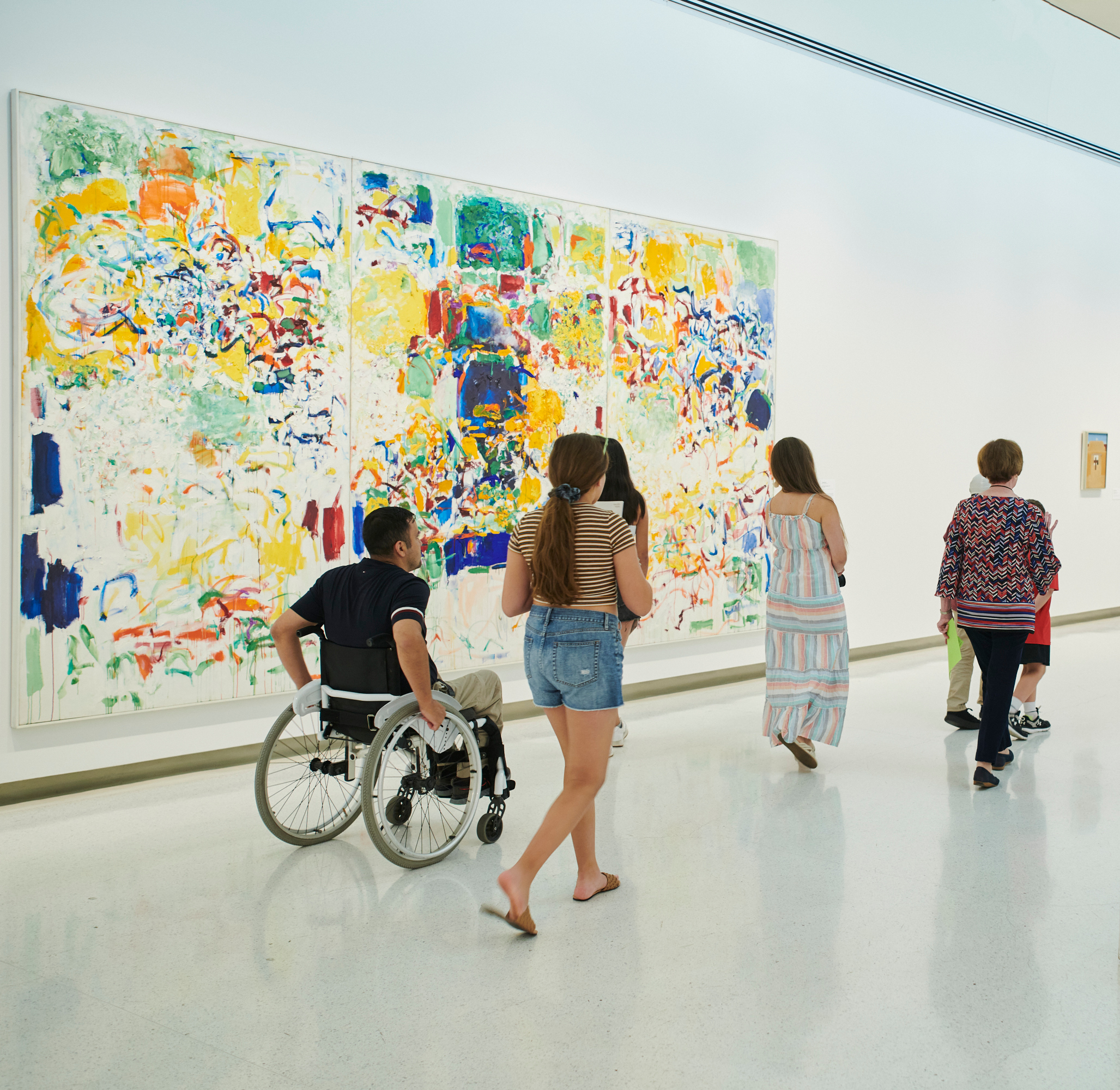

IMAGES
COMMENTS
Dinosaurs. Dinosaurs in their Time Virtual Tour Explore classic favorites, as well as some surprises, from Dinosaurs in Their Time—Carnegie Museum of Natural History's core exhibition featuring real dinosaur fossils. Museum experts guide you through an interactive experience broadcast live with amazing views of the fossils and environments on display.
Please email the Group Visits Office or call +1 412.622.3289. We look forward to hosting your group! Book your Tour →. Drop-In Tours. Daily, 1-2 p.m. Come experience our collection and special exhibitions with a group on a guided visit led by one of our friendly and knowledgeable docents, or on your own with a self-guided option.
Carnegie Museums members are invited to explore the world, virtually, with museum scientists, gain a new perspective on art masterpieces from the curators who love them, take a virtual tour of a new exhibit, and more! Carnegie Museum of Art Carnegie Science Center Carnegie Museum of Natural History The Andy Warhol Museum.
Discover the Selfies, Portraits, and Photomontages in our Vernacular Photography Collection. Online Tours.
What art is on view at the Carnegie Museum of Art. From special exhibitions to our collection galleries, there's always something new to encounter at the museum.
Did you know that Carnegie Museum of Natural History's Cenozoic Era: Age of Mammals exhibition contains more than 30 mounted real fossil … Age of Mammals: The Cenozoic Era Opens Friends of Carnegie Museum of Natural History celebrated the reopening of a popular exhibition hall this weekend and honored Joe and Kathy …
Guide To The Carnegie Museum: What To See. Let's take a tour of the best art works and masterpieces at the Carnegie Museum of Art. 1. Hall of Sculpture. The design of the Hall of Sculpture is modeled after the columned inner sanctuary of the Parthenon in Athens. It's constructed of brilliant white marble, from the same quarries used to ...
Take a virtual tour of the wildlife hall at Carnegie Museum of Natural History and investigate unique adaptations of animals and their environments through drawings and observations. Discover connections between animals, plants, and their ecosystems, and practice strategies for exploring nature wherever you are ... Carnegie Museums of Art and ...
The exhibition makes its North American debut at Carnegie Museum of Art following an inaugural presentation at the 18th Venice Biennale of Architecture in 2023. Through commissions by five artists, architects, and designers from the U.S., Everlasting Plastics considers the ways these materials both shape and erode contemporary ecologies ...
The Virtual Residence Hall Tour, led by our Tartan Ambassadors, offers a look at Carnegie Mellon's common first-year on-campus housing options. The tour will run approximately 60 minutes and provide a chance to ask our Ambassadors your questions about living on campus. If no Virtual Residence Hall Tours are available, please check out the ...
Years in the works, this project made it's debut this January at the Carnegie Natural History Museum in Pittsburgh, ... Artist Amy Garbark helped with some solid photo documentation of the installation, including creating a unique virtual tour of the space using a Matterport 3D camera.
About our Exhibition Spaces. We have art in so many spaces you wouldn't believe! Take a virtual tour of our building and get to know your museum before you step foot in our galleries.
Join Carnegie Museum of Art for a virtual collection tour honoring teachers who had careers as artists, as well as artists who were incredible teachers and mentors. The museum's talented team of docents will Zoom in on the details that you may overlook in the gallery and share the colorful stories behind some incredible artists.
Schedule a Virtual Tour. Experience The Warhol from your home or classroom! Through live videoconferencing, participants can digitally experience works of art in our galleries, watch presentations, and share in two-way conversations with museum educators. ... The Andy Warhol Museum, one of the four Carnegie Museums of Pittsburgh. Address 117 ...
Carnegie Museum of Natural History announces the launch of a growing library of virtual experiences, including four virtual field trips, available to educators and individuals around the world. Experiences are available now, with more products slated in the months ahead, to meet the growing demand for high-quality, educational online programming.
One of the most tangible examples of Andrew Carnegie's philanthropy was the founding of 2,509 libraries in the late 19th and early 20th centuries. Of these libraries, 1,679 were built in the United States. Carnegie spent over $55 million of his wealth on libraries alone, and he is often referred to as the "Patron Saint of Libraries.".
Join us for a virtual tour of artworks from our collection and be a member for the afternoon! Enjoy a close-up look at artworks and hear the stories they tell. ... These online classes were free for Carnegie Museum of Pittsburgh Members and are now available to watch for free online. 4400 Forbes Avenue Pittsburgh, PA 15213 +1 412.622.3131 ...
View Our Exhibitions. Dinosaurs and the art of Andy Warhol. Toss in a World War II submarine, original Monets, and exhibitions dedicated to robots and the science of sports. And that's only what makes us permanently interesting. We also boast constantly changing art and science exhibitions—something for everyone.
6. Go on a virtual tour of the Museum. Google Arts & Culture gives you access to 300,000 specimens within the Museum's collections, along with 35 digital exhibitions, virtual tours and an interactive gigapixel photo (so enormous you can zoom in on the tiniest detail) of Hintze Hall's gilded canopy.
Virtual Dinosaur Armor Tour! December 30, 2020, 3:00 pm - 4:00 pm. Online. Join us for a family friendly virtual tour of the premiere exhibition, Dinosaur Armor, now on display at Carnegie Museum of Natural History. Museum experts guide you through the exhibit as you explore extraordinary specimens and learn about the development of body armor ...
Hours: Friday-Wednesday: 10 a.m.-5 p.m. Thursday: 10 a.m.-8 p.m. Open seven days a week from Memorial Day through Labor Day. Closed Tuesday from Labor Day through Memorial Day. Closed for Easter, Thanksgiving, Christmas, and New Year's Day. On Thurs., July 4, 2024, the museum will close at 5 p.m.
In this volume, an interdisciplinary team of researchers shares insights from three years of intensive design research resulting in a game, Beats Empire, for formative assessment of computer science and data science skills.
Anonymous (1988) Davis Herbarium Goes to Carnegie Museum. CASTANEA 53: 83. The private herbarium of Hannibal A. and Tyrecca E. Davis has been given to the Carnegie Museum in Pittsburgh. This consists of a 10,000 sheet general collection with emphasis on West Virginia, and 10,000 sheets of Rubus, mostly from eastern North America.
In the Moment Tours at CMOA. Monthly tours designed especially for those with Alzheimer's or other forms of dementia and their caregivers. Gallery Talks at The Warhol. Dig deeper into Andy Warhol's life and work with these daily, 30-minute talks with educators, including Donald Warhola, one of Andy's nephews. ... ©2024 Carnegie Museums ...
The visually striking objects in the world premiere exhibition retain much of their captivating power when presented over electronic screens, and cell phone cameras, when paired with hand-held stabilizer units, have proven to be fully capable of live streaming all the required video. During the recently completed school year 54 virtual tours of ...
Your gift to Carnegie Museum of Art helps us champion creativity within our walls and beyond. Learn About Ways To Give →. Carnegie Museum of Art creates experiences that connect people to art, ideas, and one another. One of the four Carnegie Museums of Pittsburgh.